Time limit: 0
Quiz-summary
0 of 133 questions completed
Questions:
- 1
- 2
- 3
- 4
- 5
- 6
- 7
- 8
- 9
- 10
- 11
- 12
- 13
- 14
- 15
- 16
- 17
- 18
- 19
- 20
- 21
- 22
- 23
- 24
- 25
- 26
- 27
- 28
- 29
- 30
- 31
- 32
- 33
- 34
- 35
- 36
- 37
- 38
- 39
- 40
- 41
- 42
- 43
- 44
- 45
- 46
- 47
- 48
- 49
- 50
- 51
- 52
- 53
- 54
- 55
- 56
- 57
- 58
- 59
- 60
- 61
- 62
- 63
- 64
- 65
- 66
- 67
- 68
- 69
- 70
- 71
- 72
- 73
- 74
- 75
- 76
- 77
- 78
- 79
- 80
- 81
- 82
- 83
- 84
- 85
- 86
- 87
- 88
- 89
- 90
- 91
- 92
- 93
- 94
- 95
- 96
- 97
- 98
- 99
- 100
- 101
- 102
- 103
- 104
- 105
- 106
- 107
- 108
- 109
- 110
- 111
- 112
- 113
- 114
- 115
- 116
- 117
- 118
- 119
- 120
- 121
- 122
- 123
- 124
- 125
- 126
- 127
- 128
- 129
- 130
- 131
- 132
- 133
Information
Section III: Routing Technologies - Test Online
You have already completed the quiz before. Hence you can not start it again.
Quiz is loading...
You must sign in or sign up to start the quiz.
You have to finish following quiz, to start this quiz:
Results
0 of 133 questions answered correctly
Your time:
Time has elapsed
You have reached 0 of 0 points, (0)
| Average score |
|
| Your score |
|
Categories
- Not categorized 0%
- 1
- 2
- 3
- 4
- 5
- 6
- 7
- 8
- 9
- 10
- 11
- 12
- 13
- 14
- 15
- 16
- 17
- 18
- 19
- 20
- 21
- 22
- 23
- 24
- 25
- 26
- 27
- 28
- 29
- 30
- 31
- 32
- 33
- 34
- 35
- 36
- 37
- 38
- 39
- 40
- 41
- 42
- 43
- 44
- 45
- 46
- 47
- 48
- 49
- 50
- 51
- 52
- 53
- 54
- 55
- 56
- 57
- 58
- 59
- 60
- 61
- 62
- 63
- 64
- 65
- 66
- 67
- 68
- 69
- 70
- 71
- 72
- 73
- 74
- 75
- 76
- 77
- 78
- 79
- 80
- 81
- 82
- 83
- 84
- 85
- 86
- 87
- 88
- 89
- 90
- 91
- 92
- 93
- 94
- 95
- 96
- 97
- 98
- 99
- 100
- 101
- 102
- 103
- 104
- 105
- 106
- 107
- 108
- 109
- 110
- 111
- 112
- 113
- 114
- 115
- 116
- 117
- 118
- 119
- 120
- 121
- 122
- 123
- 124
- 125
- 126
- 127
- 128
- 129
- 130
- 131
- 132
- 133
- Answered
- Review
-
Question 1 of 133
1. Question
1 pointsWhich three statements about link-state routing are true? (Choose three.)Correct
Incorrect
-
Question 2 of 133
2. Question
1 pointsA router has learned three possible routes that could be used to reach a destination network. One route is from EIGRP and has a composite metric of 20514560. Another route is from OSPF with a metric of 782. The last is from RIPv2 and has a metric of 4. Which route or routes will the router install in the routing table?Correct
Incorrect
Hint
When one route is advertised by more than one routing protocol, the router will choose to use the routing protocol which has lowest Administrative Distance. The Administrative Distances of popular routing protocols are listed below: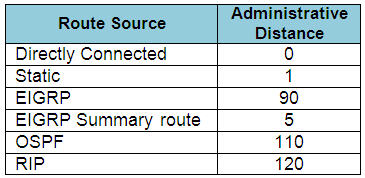
-
Question 3 of 133
3. Question
1 pointsA network administrator is troubleshooting an EIGRP problem on a router and needs to confirm the IP addresses of the devices with which the router has established adjacency. The retransmit interval and the queue counts for the adjacent routers also need to be checked. What command will display the required information?Correct
Incorrect
Hint
Below is an example of the “show ip eigrp neighbors” output. Let’s analyze these columns:
+ H: lists the neighbors in the order this router was learned
+ Address: the IP address of the neighbors
+ Interface: the interface of the local router on which this Hello packet was received
+ Hold (sec): the amount of time left before neighbor is considered in “down” status
+ Uptime: amount of time since the adjacency was established
+ SRTT (Smooth Round Trip Timer): the average time in milliseconds between the transmission of a packet to a neighbor and the receipt of an acknowledgement.
+ RTO (Retransmission Timeout): if a multicast has failed, then a unicast is sent to that particular router, the RTO is the time in milliseconds that the router waits for an acknowledgement of that unicast.
+ Queue count (Q Cnt): shows the number of queued EIGRP packets. It is usually 0.
+ Sequence Number (Seq Num): the sequence number of the last update EIGRP packet received. Each update message is given a sequence number, and the received ACK should have the same sequence number. The next update message to that neighbor will use Seq Num + 1.
In this question we have to check the RTO and Q cnt fields.
Let’s analyze these columns:
+ H: lists the neighbors in the order this router was learned
+ Address: the IP address of the neighbors
+ Interface: the interface of the local router on which this Hello packet was received
+ Hold (sec): the amount of time left before neighbor is considered in “down” status
+ Uptime: amount of time since the adjacency was established
+ SRTT (Smooth Round Trip Timer): the average time in milliseconds between the transmission of a packet to a neighbor and the receipt of an acknowledgement.
+ RTO (Retransmission Timeout): if a multicast has failed, then a unicast is sent to that particular router, the RTO is the time in milliseconds that the router waits for an acknowledgement of that unicast.
+ Queue count (Q Cnt): shows the number of queued EIGRP packets. It is usually 0.
+ Sequence Number (Seq Num): the sequence number of the last update EIGRP packet received. Each update message is given a sequence number, and the received ACK should have the same sequence number. The next update message to that neighbor will use Seq Num + 1.
In this question we have to check the RTO and Q cnt fields. -
Question 4 of 133
4. Question
1 pointsWhich command can you enter to verify that a BGP connection to a remote device is established?Correct
Incorrect
Hint
This command can be used to verify if a BGP connection to a BGP neighbor is good or not. Let’s see an example: Please pay attention to the “State/PfxRcd” column of the output. It indicates the number of prefixes that have been received from a neighbor. If this value is a number (including “0”, which means BGP neighbor does not advertise any route) then the BGP neighbor relationship is good. If this value is a word (including “Idle”, “Connect”, “Active”, “OpenSent”, “OpenConfirm”) then the BGP neighbor relationship is not good.
In the outputs above we see the BGP neighbor relationship between R1 & 10.1.1.1 is good with 2 Prefix Received (PfxRcd) while the BGP neighbor relationships between R1 & 10.2.2.2; R1 & 10.3.3.3 are not good (they are in “Active” and “Idle” state).
Please pay attention to the “State/PfxRcd” column of the output. It indicates the number of prefixes that have been received from a neighbor. If this value is a number (including “0”, which means BGP neighbor does not advertise any route) then the BGP neighbor relationship is good. If this value is a word (including “Idle”, “Connect”, “Active”, “OpenSent”, “OpenConfirm”) then the BGP neighbor relationship is not good.
In the outputs above we see the BGP neighbor relationship between R1 & 10.1.1.1 is good with 2 Prefix Received (PfxRcd) while the BGP neighbor relationships between R1 & 10.2.2.2; R1 & 10.3.3.3 are not good (they are in “Active” and “Idle” state). -
Question 5 of 133
5. Question
1 pointsWhich command can you enter to set the default route for all traffic to an interface?Correct
Incorrect
-
Question 6 of 133
6. Question
1 pointsInstructions: – Enter IOS commands on the device to verify network operation and answer the multiple questions. – THIS TASK DOES NOT REQUIRE DEVICE CONFIGURATION. – Click the device icon to gain access to the console device. No console or enable passwords are required. – To access the multiple choice questions, click the numbered boxes on the left of the top panel. – there are four multiple-choice questions with this task. Be sure to answer all four questions before clicking Next.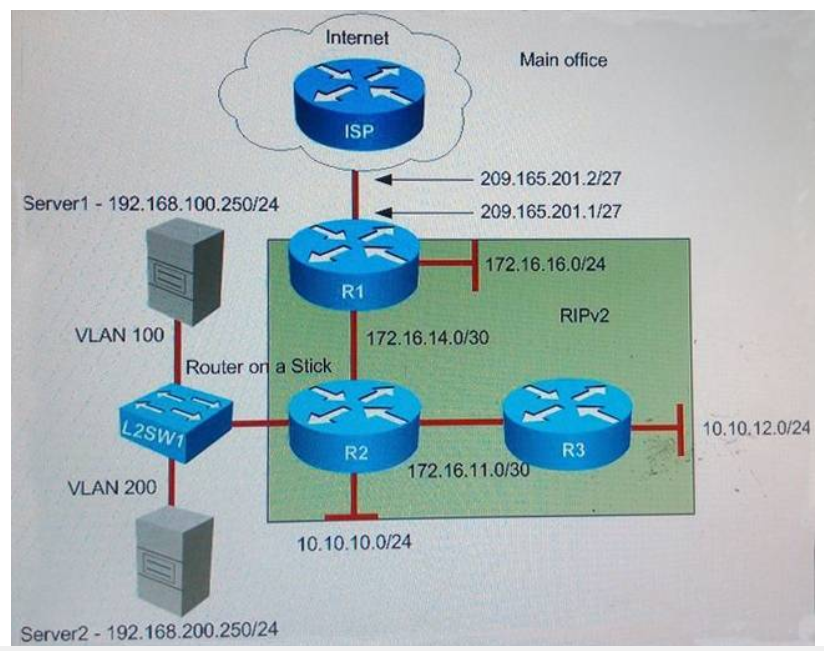 Server1 and Server2 are unable to communicate with the rest of the network. Your initial check with system administrators shows that IP address settings are correctly configured on the server side. What could be an issue? Correct
Server1 and Server2 are unable to communicate with the rest of the network. Your initial check with system administrators shows that IP address settings are correctly configured on the server side. What could be an issue? Correct
Incorrect
Hint
Check the configuration of the interface that is connected to Server1 and Server2 on R2 with “show runningconfig” command.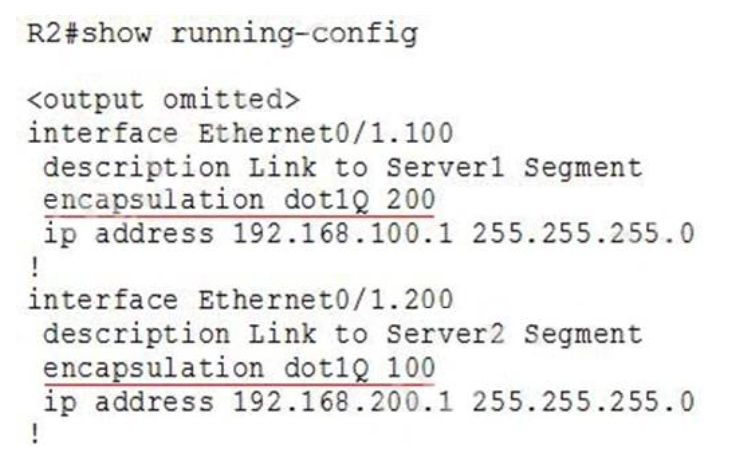 We see that subinterface E0/1.100 has been configured with VLAN 200 (via “encapsulation dot1Q 200”
command) while Server1 belongs to VLAN 100. Therefore this configuration is not correct. It should be
“encapsulation dot1Q 100” instead. The same thing for interface E0/1.200, it should be “encapsulation dot1Q
200” instead.
We see that subinterface E0/1.100 has been configured with VLAN 200 (via “encapsulation dot1Q 200”
command) while Server1 belongs to VLAN 100. Therefore this configuration is not correct. It should be
“encapsulation dot1Q 100” instead. The same thing for interface E0/1.200, it should be “encapsulation dot1Q
200” instead. -
Question 7 of 133
7. Question
1 pointsInstructions: – Enter IOS commands on the device to verify network operation and answer the multiple questions. – THIS TASK DOES NOT REQUIRE REVICE CINFIGURATION. – Click the device icon to gain access to the console device. No console or enable passwords are required. – To access the multiple choice questions, click the numbered boxes on the left of the top panel. – there are four multiple-choice questions with this task. Be sure to answer all four questions before clicking Next. Examine the R2 configuration. The traffic that is destined to the R3 LAN network that is sourced from R2 is forwarded to R1 instead of R3. What could be an issue? R2#traceroute 10.10.12.1 source 10.10.10.1 Type escape sequence to abort Tracing the route to 10.10.12.1 VRF info: (vrf in name/id, vrf out name/id) 1 172.16.14.1 0 msec 1 msec 0 msec 2 172.16.14.1 !H !H * R2#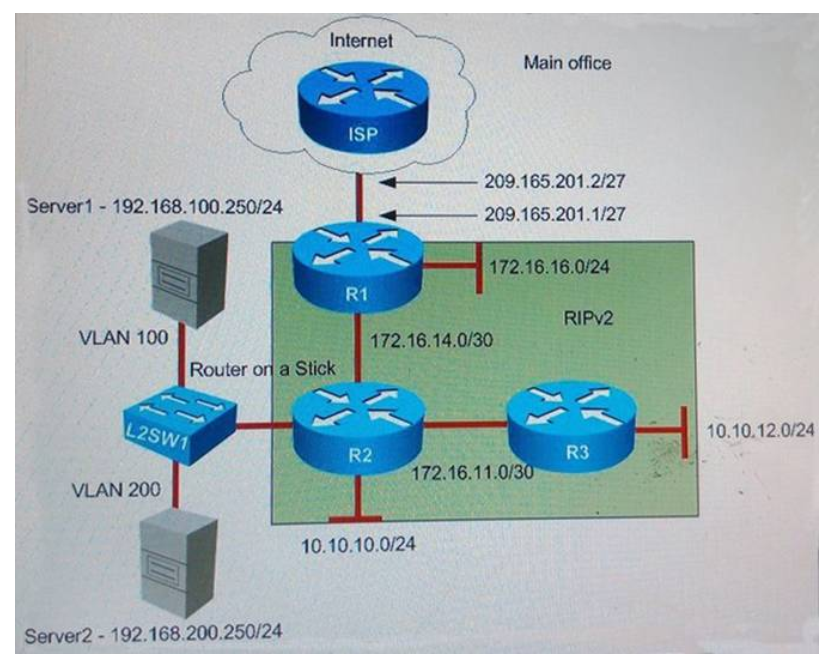 Correct
Correct
Incorrect
Hint
First we should check the routing table of R2 with the “show ip route” command.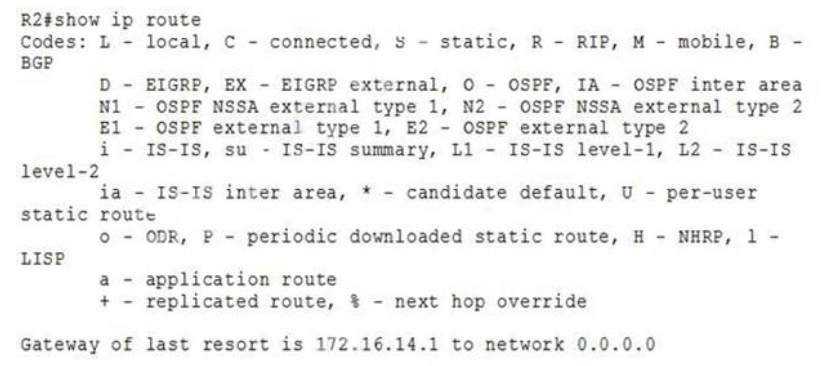
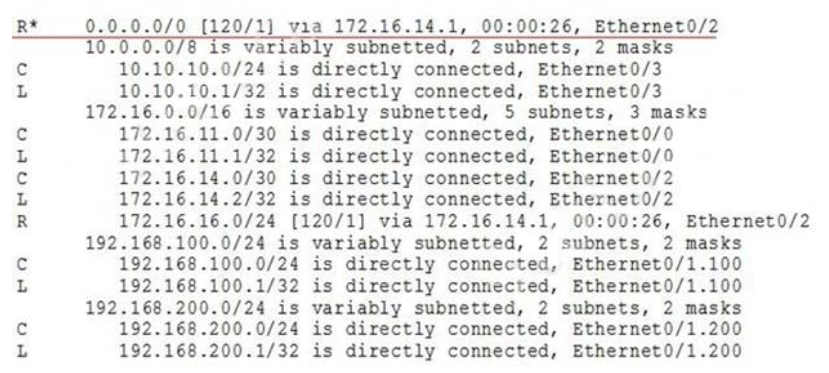 In this table we cannot find the subnet “10.10.12.0/24” (R3 LAN network) so R2 will use the default route
advertised from R1 (with the command “default-information originate” on R1) to reach unknown destination, in
this case subnet 10.10.12.0/24 -> R2 will send traffic to 10.10.12.0/24 to R1.
Next we need to find out why R3 did not advertise this subnet to R2. A quick check with the “show runningconfig” on R3 we will see that R3 was not configured with RIP ( no “router rip” section). Therefore, we can
conclude RIPv2 was not enabled on R3.
In this table we cannot find the subnet “10.10.12.0/24” (R3 LAN network) so R2 will use the default route
advertised from R1 (with the command “default-information originate” on R1) to reach unknown destination, in
this case subnet 10.10.12.0/24 -> R2 will send traffic to 10.10.12.0/24 to R1.
Next we need to find out why R3 did not advertise this subnet to R2. A quick check with the “show runningconfig” on R3 we will see that R3 was not configured with RIP ( no “router rip” section). Therefore, we can
conclude RIPv2 was not enabled on R3. -
Question 8 of 133
8. Question
1 pointsInstructions: – Enter IOS commands on the device to verify network operation and answer the multiple questions. – THIS TASK DOES NOT REQUIRE REVICE CINFIGURATION. – Click the device icon to gain access to the console device. No console or enable passwords are required. – To access the multiple choice questions, click the numbered boxes on the left of the top panel. – there are four multiple-choice questions with this task. Be sure to answer all four questions before clicking Next.Which statement is correct, based on the R1 routing table?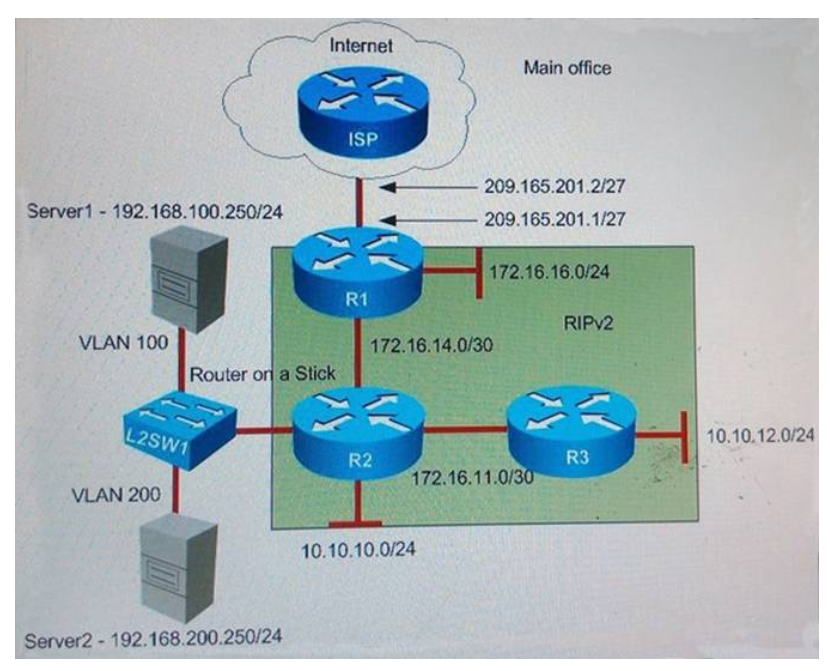 Correct
Correct
Incorrect
Hint
First use the “show ip route” command to check the R1 routing table: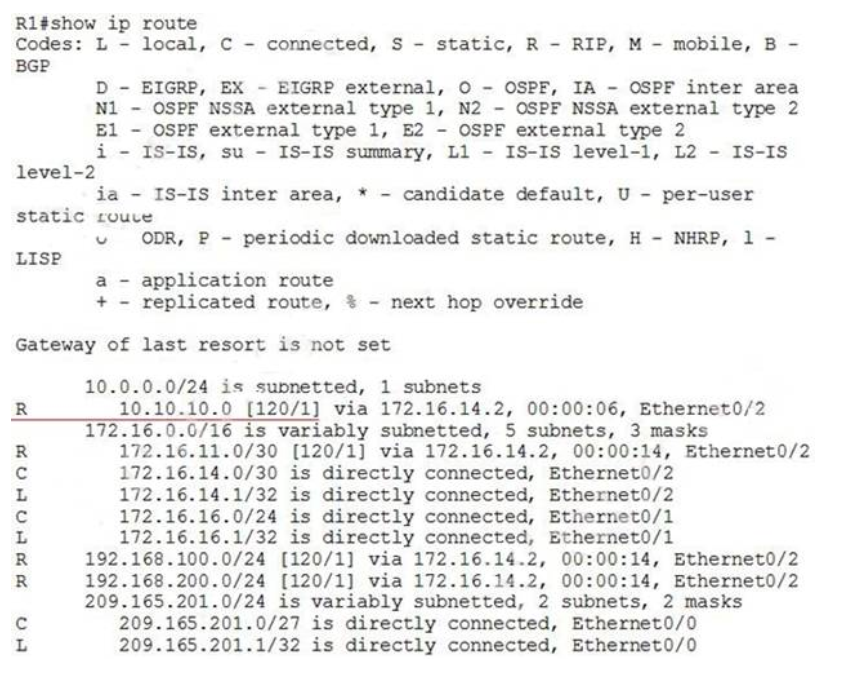 As we see here, 10.10.10/24 is learned from RIP. Notice that although there is a static route on R1 to this destination (you can check with the “show running-config” on R1 to see the line “ip route 10.10.10.0 255.255.255.0 172.16.14.2 200”), this static route is not installed to the routing table because it is not the best path because the Administrative Distance (AD) of this static route is 200 while the AD of RIP is 120 so R1 chose the path with lowest AD so it chose path advertised via RIP.
As we see here, 10.10.10/24 is learned from RIP. Notice that although there is a static route on R1 to this destination (you can check with the “show running-config” on R1 to see the line “ip route 10.10.10.0 255.255.255.0 172.16.14.2 200”), this static route is not installed to the routing table because it is not the best path because the Administrative Distance (AD) of this static route is 200 while the AD of RIP is 120 so R1 chose the path with lowest AD so it chose path advertised via RIP. -
Question 9 of 133
9. Question
1 pointsInstructions: – Enter IOS commands on the device to verify network operation and answer the multiple questions. – THIS TASK DOES NOT REQUIRE DEVICE CONFIGURATION. – Click the device icon to gain access to the console device. No console or enable passwords are required. – To access the multiple choice questions, click the numbered boxes on the left of the top panel. – there are four multiple-choice questions with this task. Be sure to answer all four questions before clicking Next.Users in the main office complain that they are unable to reach Internet sites. You observe that Internet traffic that is destined towards ISP router is not forwarded correctly on R1. What could be an issue? Ping to Internet server shows the following results from R1: R1#ping 209.165.200.225 Type escape sequence to abort. Sending 5, 100-byte ICMP Echos to 209.165.200.225, time out is 2 seconds. Success rate is 0 percent (0/5)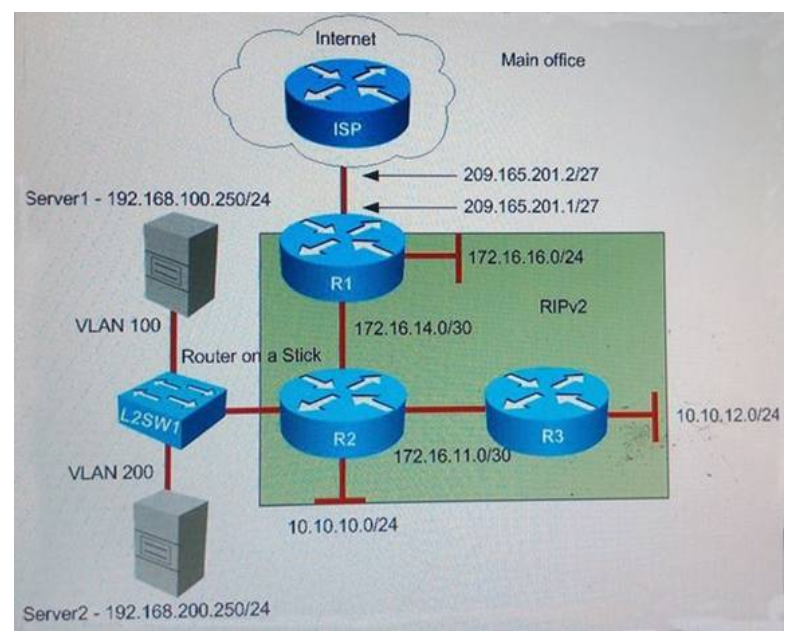 Correct
Correct
Incorrect
Hint
When all the users cannot reach internet sites we should check on the router connecting to the ISP to see if it has a default route pointing to the ISP or not. Use the “show ip route” command on R1: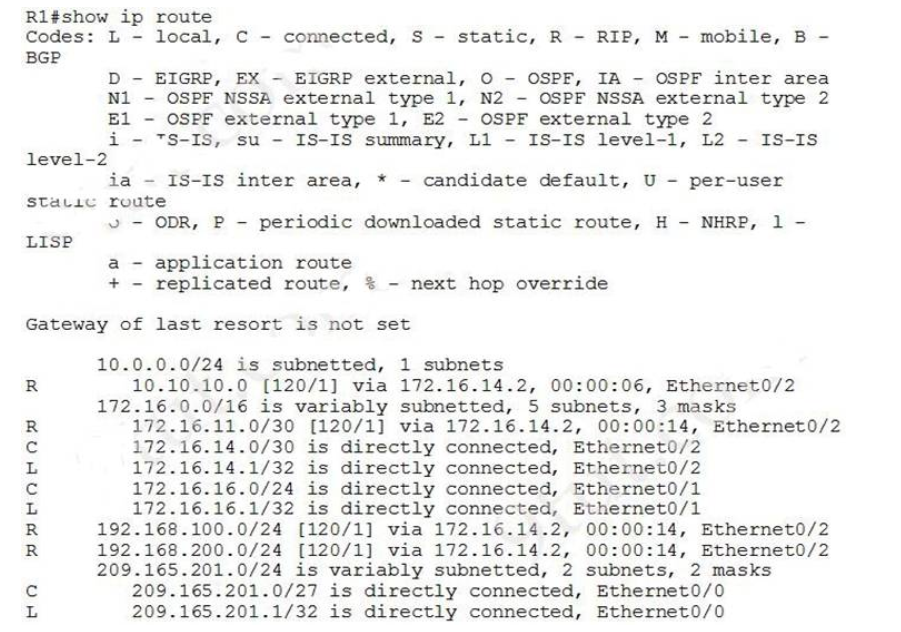 We cannot find a default route on R1 (something like this: S* 0.0.0.0/0 [1/0] via 209.165.201.2) so maybe R1 was not configured with a default route. We can check with the “show running-config” on R1:
https://itexamanswers.net/wp-content/uploads/2019/08/434gt2.png
We need a configure a default route (“ip route 0.0.0.0 0.0.0.0 209.165.201.2”) but we cannot find here so we can conclude R1 was not be configured with a default route pointing to the ISP router.
We cannot find a default route on R1 (something like this: S* 0.0.0.0/0 [1/0] via 209.165.201.2) so maybe R1 was not configured with a default route. We can check with the “show running-config” on R1:
https://itexamanswers.net/wp-content/uploads/2019/08/434gt2.png
We need a configure a default route (“ip route 0.0.0.0 0.0.0.0 209.165.201.2”) but we cannot find here so we can conclude R1 was not be configured with a default route pointing to the ISP router. -
Question 10 of 133
10. Question
1 pointsRefer to the exhibit. If R1 sends traffic to 192.168.10.45, the traffic is sent through which interface?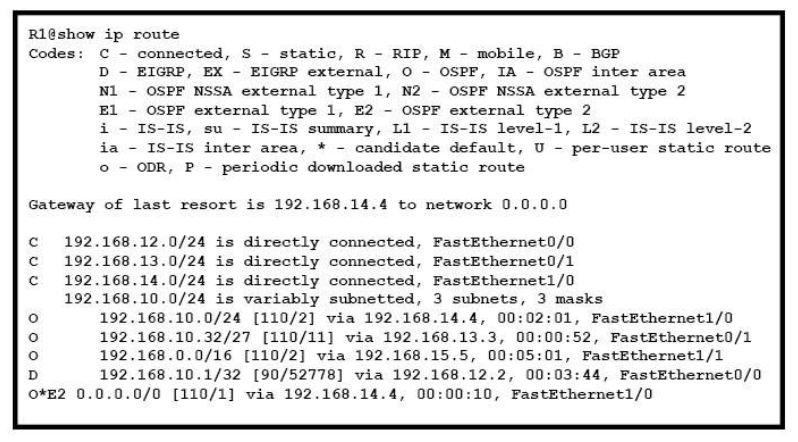 Correct
Correct
Incorrect
Hint
192.168.10.45 belongs to 192.168.10.32/27 subnet (range from 192.168.10.32 to 192.168.10.63) so the router will use FastEthernet0/1 as the exit interface. -
Question 11 of 133
11. Question
1 pointsTo enable router on a stick on a router subinterface, which two steps must you perform? (Choose two.)Correct
Incorrect
-
Question 12 of 133
12. Question
1 pointsWhich two statements about floating static routes are true? (Choose two)Correct
Incorrect
Hint
Floating static routes are static routes that have an administrative distance greater than the administrative distance (AD) of another static route or dynamic routes. By default a static route has an AD of 1 then floating static route must have the AD greater than 1. Floating static route has a manually configured administrative distance greater than that of the primary route and therefore would not be in the routing table until the primary route fails. -
Question 13 of 133
13. Question
1 pointsRefer to the exhibit. If RTR01 is configured as shown, which three addresses will be received by other routers that are running EIGRP on the network?(choose three) Correct
Correct
Incorrect
-
Question 14 of 133
14. Question
1 pointsinterface Loopback0 ip address 172.16.1.33 255.255.255.224 router bgp 999 neighbor 10.1.5.2 remote-as 65001
Refer to the exhibit . Which Command do you enter so that R1 advertises the loopback0 interface to the BGP Peers?Correct
Incorrect
Hint
First please notice that unlike other routing protocols like OSPF or EIGRP, we have to use subnet mask, not wildcard mask, to advertise the routes in the “network” command -> C is not correct.Secondly, with BGP, you must advertise the correct network and subnet mask in the “network” command ( in this case network 172.16.1.32/27). BGP is very strict in the routing advertisements. In other words, BGP only advertises the network which exists exactly in the routing table (in this case network x.x.x.32/27 exists in the routing table as the Fa0/0 interface). If you put the command “network x.x.0.0 mask 255.255.0.0” or “network x.0.0.0 mask 255.0.0.0” or “network x.x.x.33 mask 255.255.255.255” then BGP will not advertise anything.Therefore the full command in this question is “network 172.16.1.32 mask 255.255.255.224”. For more information about BGP configuration, please read our Basic BGP Configuration tutorial. -
Question 15 of 133
15. Question
1 pointsBased on the exhibited routing table, how will packets from a host within the 192.168.10.192/26 LAN be forwarded to 192.168.10.1?Correct
Incorrect
Hint
From the routing table we learn that network 192.168.10.0/30 is learned via 2 equal-cost paths (192.168.10.9 &192.168.10.5) -> traffic to this network will be load-balancing. -
Question 16 of 133
16. Question
1 pointsWhich definition of default route is true?Correct
Incorrect
Hint
A host route for IPv4 has the mask /32, and a host route for IPv6 has the mask /128. If an IPv4 address is configured with a mask of /32 on an interface of the router, which is typical for loopback interfaces, the host route appears in the routing table only as connected (for example in the routing table we will see this line: “C 10.10.10.1/32 is directly connected, Loopback0”. Reference: https://www.cisco.com/c/en/us/support/docs/ip/ip-routing/116264-technote-ios-00.html -
Question 17 of 133
17. Question
1 pointsWhich value must you configure on a device before EIGRP for IPv6 can start running?Correct
Incorrect
-
Question 18 of 133
18. Question
1 pointsWhich option describes a difference between EIGRP for IPv4 and IPv6?Correct
Incorrect
Hint
To configure EIGRP for IPv6 we must explicitly specify a router ID before it can start running. For example:ipv6 router eigrp 1 eigrp router-id 2.2.2.2 no shutdown
EIGRPv3 also uses the AS number (for example: ipv6 eigrp 1 under interface mode).Notice that EIGRP for IPv6 router-id must be an IPv4 address. EIGRP for IPv4 can automatically pick-up an IPv4 to use as its EIGRP router-id with this rule: + The highest IP address assigned to a loopback interface is selected as the router ID. + If there are not any loopback addresses configured, the highest IP address assigned to any other active interface is chosen as the router ID -
Question 19 of 133
19. Question
1 pointsRefer to the exhibit. When running OSPF, What would cause router A not to form an adjacency with router B? Correct
Correct
Incorrect
Hint
To form an adjacency (become neighbor), router A & B must have the same Hello interval, Dead interval and AREA number. -
Question 20 of 133
20. Question
1 pointsWhich two steps must you perform on each device that is configured for IPv4 routing before you implement OSPFv3?(Choose two)Correct
Incorrect
Hint
Before you enable OSPF for IPv6 on an interface, you must perform the following:+ Complete the OSPF network strategy and planning for your IPv6 network. For example, you must decide whether multiple areas are required. + Enable IPv6 unicast routing. + Enable IPv6 on the interface.Reference: https://www.cisco.com/c/en/us/support/docs/ip/ip-version-6-ipv6/112100-ospfv3-config-guide.html Note: If we have already had an active interface, we don’t need to configure the router ID for OSPFv3 anymore because the device will automatically choose that IPv4 address for its router ID). -
Question 21 of 133
21. Question
1 pointsWhich command must you enter to enable OSPFV2 in an IPV4 network?Correct
Incorrect
-
Question 22 of 133
22. Question
1 pointsRefer to the exhibit. Given the output from the show ip eigrp topology command, which router is the feasible successor? Correct
Correct
Incorrect
-
Question 23 of 133
23. Question
1 pointsWhich IPv6 routing protocol uses multicast group FF02::9 to send updates?Correct
Incorrect
Hint
Below lists some reserved and well-known IPv6 multicast address in the reserved multicast address range:FF01::1 All IPv6 nodes within the node-local scope FF01::2 All IPv6 routers within the node-local scope FF02::1 All IPv6 nodes within the link-local scope FF02::2 All IPv6 routers within the link-local scope FF02::5 All OSPFv3 routers within the link-local scope FF02::6 All OSPFv3 designated routers within the link-local scope FF02::9 All RIPng routers within the link-local scope FF02::A All EIGRP routers within the link-local scope FF02::D All PIM routers within the link-local scope FF02::1:2 All DHCPv6 agents (servers and relays) within the link-local scope FF05::2 All IPv6 routers within the site-local scope FF02::1:FF00:0/104 IPv6 solicited-node multicast address within the link-local scope -
Question 24 of 133
24. Question
1 pointsWhich functionality does an SVI provide?Correct
Incorrect
-
Question 25 of 133
25. Question
1 pointsIf two OSPF neighbors have formed complete adjacency and are exchanging link-state advertisements, which state have they reached?Correct
Incorrect
-
Question 26 of 133
26. Question
1 pointsWhich three statements describe the reasons large OSPF networks use a hierarchical design? (Choose three.)Correct
Incorrect
Hint
Hierarchical design of OSPF (basically means that you can separate the larger internetwork into smaller internetworks called areas) helps us create a network with all features listed above (decrease routing overhead, speed up convergence, confine network instability to single areas of the network). -
Question 27 of 133
27. Question
1 pointsafter you apply the give configurations to R1 and R2 you notice that OSPFv3 fails to start Which reason for the problem is most likely true ?Correct
Incorrect
-
Question 28 of 133
28. Question
1 pointsWhich two statements about RIPv2 are true? (Choose two)Correct
Incorrect
-
Question 29 of 133
29. Question
1 pointsWhich two statements about eBGP neighbor relationships are true? (Choose two)Correct
Incorrect
-
Question 30 of 133
30. Question
1 pointsWhich two statements about EIGRP on IPv6 networks are true? (Choose two.)Correct
Incorrect
Hint
http://www.cisco.com/c/en/us/support/docs/ip/enhanced-interior-gateway-routing-protocol-eigrp/113267-eigrp-ipv6-00.html -
Question 31 of 133
31. Question
1 pointsWhich command is used to display the collection of OSPF link states?Correct
Incorrect
Hint
The “show ip ospf database” command displays the link states. Here is an example: Here is the lsa database on R2. R2#show ip ospf database OSPF Router with ID (2.2.2.2) (Process ID 1) Router Link States (Area 0) Link ID ADV Router Age Seq# Checksum Link count2.2.2.2 2.2.2.2 793 0x80000003 0x004F85 210.4.4.4 10.4.4.4 776 0x80000004 0x005643 1111.111.111.111 111.111.111.111 755 0x80000005 0x0059CA 2133.133.133.133 133.133.133.133 775 0x80000005 0x00B5B1 2 Net Link States (Area 0) Link ID ADV Router Age Seq# Checksum10.1.1.1 111.111.111.111 794 0x80000001 0x001E8B10.2.2.3 133.133.133.133 812 0x80000001 0x004BA910.4.4.1 111.111.111.111 755 0x80000001 0x007F1610.4.4.3 133.133.133.133 775 0x80000001 0x00C31F -
Question 32 of 133
32. Question
1 pointsIf IP routing is enabled, which two commands set the gateway of last resort to the default gateway? (Choose two.)Correct
Incorrect
Hint
Both the “ip default-network” and “ip route 0.0.0.0 0.0.0.0 (next hop)” commands can be used to set the default gateway in a Cisco router. -
Question 33 of 133
33. Question
1 pointsWhich parameter would you tune to affect the selection of a static route as a backup, when a dynamic protocol is also being used?Correct
Incorrect
Hint
By default, the administrative distance of a static route is 1, meaning it will be preferred over all dynamic routing protocols. If you want to have the dynamic routing protocol used and have the static route be used only as a backup, you need to increase the AD of the static route so that it is higher than the dynamic routing protocol. -
Question 34 of 133
34. Question
1 pointsRefer to the exhibit. A network associate has configured OSPF with the command: City(config-router)# network 192.168.12.64 0.0.0.63 area 0 After completing the configuration, the associate discovers that not all the interfaces are participating in OSPF. Which three of the interfaces shown in the exhibit will participate in OSPF according to this configuration statement? (Choose three.)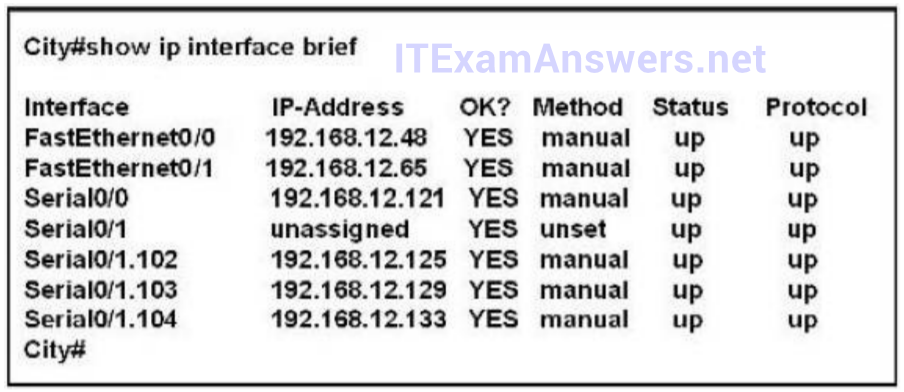 Correct
Correct
Incorrect
Hint
The “network 192.168.12.64 0.0.0.63 equals to network 192.168.12.64/26. This network has: + Increment: 64 (/26= 1111 1111.1111 1111.1111 1111.1100 0000) + Network address: 192.168.12.64 + Broadcast address: 192.168.12.127 Therefore, all interface in the range of this network will join OSPF. -
Question 35 of 133
35. Question
1 pointsRefer to the exhibit. The Lakeside Company has the internetwork in the exhibit. The administrator would like to reduce the size of the routing table on the Central router. Which partial routing table entry in the Central router represents a route summary that represents the LANs in Phoenix but no additional subnets?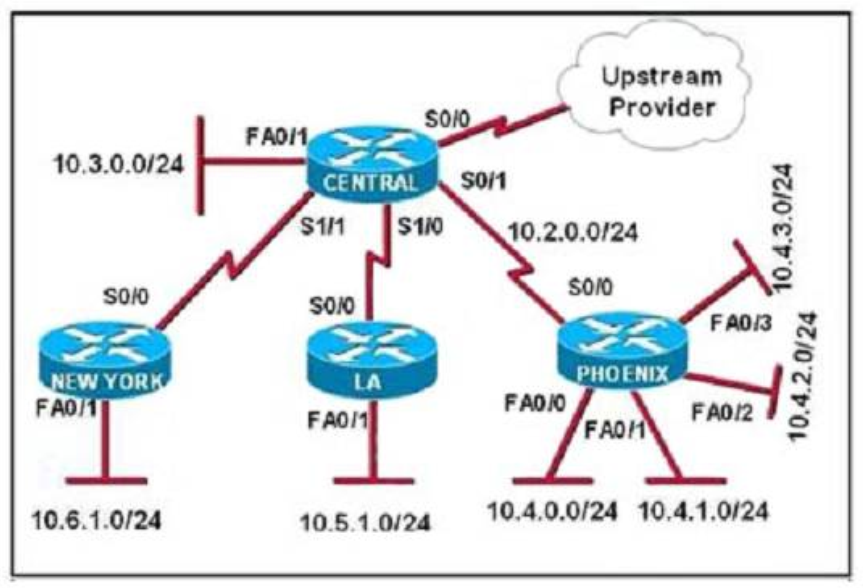 Correct
Correct
Incorrect
Hint
The 10.4.0.0/22 route includes 10.4.0.0/24, 10.4.1.0/24, 10.4.2.0/24 and 10.4.3.0/24 only. -
Question 36 of 133
36. Question
1 pointsRefer to the graphic. A static route to the 10.5.6.0/24 network is to be configured on the HFD router. Which commands will accomplish this? (Choose two.)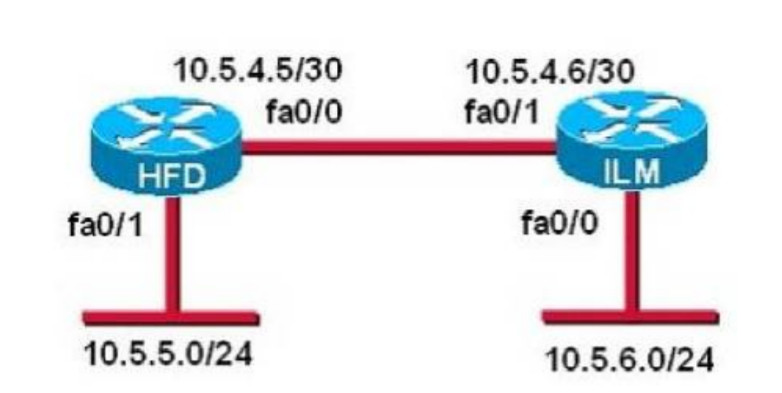 Correct
Correct
Incorrect
Hint
The simple syntax of static route: ip route destination-network-address subnet-mask {next-hop-IP-address | exit-interface} + destination-networkaddress: destination network address of the remote network + subnet mask: subnet mask of the destination network + next-hop-IP-address: the IP address of the receiving interface on the next-hop router + exit-interface: the local interface of this router where the packets will go out in the statement “ip route 10.5.6.0 255.255.255.0 fa0/0: + 10.5.6.0 255.255.255.0: the destination network +fa0/0: the exit-interface -
Question 37 of 133
37. Question
1 pointsWhat information does a router running a link-state protocol use to build and maintain its topological database? (Choose two.)Correct
Incorrect
Hint
Neighbor discovery is the first step in getting a link state environment up and running. In keeping with the friendly neighbor terminology, a Hello protocol is used for this step. The protocol will define a Hello packet format and a procedure for exchanging the packets and processing the information the packets contain. After the adjacencies are established, the routers may begin sending out LSAs. As the term flooding implies, the advertisements are sent to every neighbor. In turn, each received LSA is copied and forwarded to every neighbor except the one that sent the LSA. -
Question 38 of 133
38. Question
1 pointsWhich statements describe the routing protocol OSPF? (Choose three.)Correct
Incorrect
Hint
The OSPF protocol is based on link-state technology, which is a departure from the Bellman-Ford vector based algorithms used in traditional Internet routing protocols such as RIP. OSPF has introduced new concepts such as authentication of routing updates, Variable Length Subnet Masks (VLSM), route summarization, and so forth. OSPF uses flooding to exchange link-state updates between routers. Any change in routing information is flooded to all routers in the network. Areas are introduced to put a boundary on the explosion of link-state updates. Flooding and calculation of the Dijkstra algorithm on a router is limited to changes within an area. -
Question 39 of 133
39. Question
1 pointsWhat is the default administrative distance of OSPF?Correct
Incorrect
Hint
Administrative distance is the feature that routers use in order to select the best path when there are two or more different routes to the same destination from two different routing protocols. Administrative distance defines the reliability of a routing protocol. Each routing protocol is prioritized in order of most to least reliable (believable) with the help of an administrative distance value. Default Distance Value Table This table lists the administrative distance default values of the protocols that Cisco supports: Route Source Default Distance Values Connected interface Static route Enhanced Interior Gateway Routing Protocol (EIGRP) summary route External Border Gateway Protocol(BGP) Internal EIGRP IGRP OSPF Intermediate System-to-Intermediate System (IS-IS) Routing Information Protocol (RIP) Exterior Gateway Protocol (EGP) On Demand Routing (ODR) External EIGRP Internal BGP Unknown* -
Question 40 of 133
40. Question
1 pointsRefer to the exhibit. C-router is to be used as a “router-on-a-stick” to route between the VLANs. All the interfaces have been properly configured and IP routing is operational. The hosts in the VLANs have been configured with the appropriate default gateway. What is true about this configuration?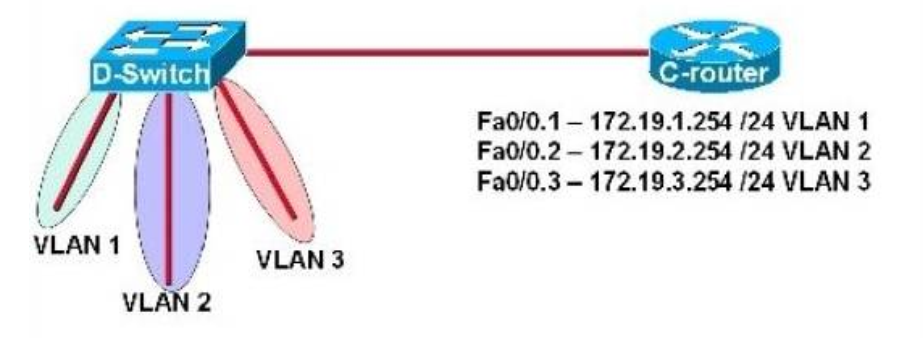 Correct
Correct
Incorrect
Hint
Since all the same router (C-router) is the default gateway for all three VLANs, all traffic destined to a different VLA will be sent to the C-router. The C-router will have knowledge of all three networks since they will appear as directly connected in the routing table. Since the C-router already knows how to get to all three networks, no routing protocols need to be configured. -
Question 41 of 133
41. Question
1 pointsRefer to the exhibit. According to the routing table, where will the router send a packet destined for 10.1.5.65?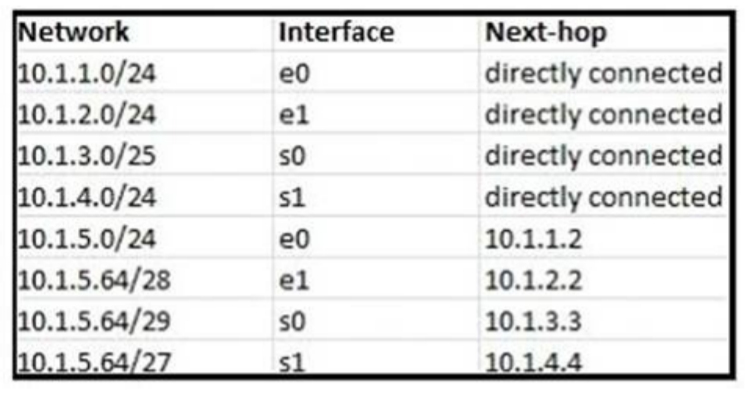 Correct
Correct
Incorrect
Hint
The destination IP address 10.1.5.65 belongs to 10.1.5.64/28, 10.1.5.64/29 & 10.1.5.64/27 subnets but the “longest prefix match” algorithm will choose the most specific subnet mask -> the prefix “/29 will be chosen to route the packet. Therefore, the next-hop should be 10.1.3.3 ->. -
Question 42 of 133
42. Question
1 pointsRefer to the exhibit. Which address and mask combination represents a summary of the routes learned by EIGRP?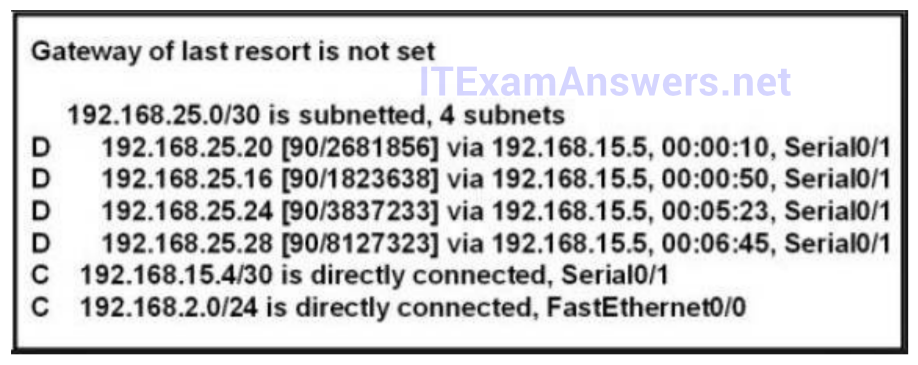 Correct
Correct
Incorrect
Hint
The binary version of 20 is 10100. The binary version of 16 is 10000. The binary version of 24 is 11000. The binary version of 28 is 11100. The subnet mask is /28. The mask is 255.255.255.240. Note: From the output above, EIGRP learned 4 routes and we need to find out the summary of them: + 192.168.25.16 + 192.168.25.20 + 192.168.25.24 + 192.168.25.28 -> The increment should bE. 28 ?16 = 12 but 12 is not an exponentiation of 2 so we must choose 16 (24). Therefore, the subnet mask is /28 (=1111 1111.1111 1111.1111 1111.11110000) = 255.255.255.240 So the best answer should be 192.168.25.16 255.255.255.240 -
Question 43 of 133
43. Question
1 pointsRefer to the exhibit. Given the output for this command, if the router ID has not been manually set, whatrouter ID will OSPF use for this router? Correct
Correct
Incorrect
Hint
The highest IP address of all loopback interfaces will be chosen -> Loopback 0 will be chosen as the router ID. -
Question 44 of 133
44. Question
1 pointsWhich two statements describe the process identifier that is used in the command to configure OSPF on arouter? (Choose two.) Router(config)# router ospf 1Correct
Incorrect
Hint
Multiple OSPF processes can be configured on a router using multiple process ID’s. The valid process ID’s are shown below: Edge-B(config)#router ospf ? <1-65535> Process ID -
Question 45 of 133
45. Question
1 pointsRefer to the exhibit. What commands must be configured on the 2950 switch and the router to allow communication between host 1 and host 2? (Choose two.)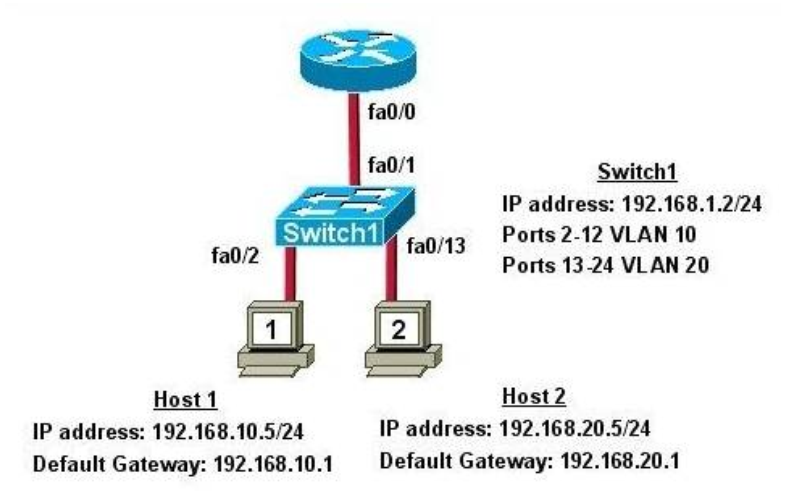 Correct
Correct
Incorrect
-
Question 46 of 133
46. Question
1 pointsWhich commands are required to properly configure a router to run OSPF and to add network 192.168.16.0/24 to OSPF area 0? (Choose two.)Correct
Incorrect
Hint
In the router ospf command, the ranges from 1 to 65535 so o is an invalid number -> but To configure OSPF, we need a wildcard in the “network” statement, not a subnet mask. We also need to assgin an area to this process -> . -
Question 47 of 133
47. Question
1 pointsWhich type of EIGRP route entry describes a feasible successor?Correct
Incorrect
Hint
EIGRP uses the Neighbor Table to list adjacent routers. The Topology Table list all the learned routers to destination whilst the Routing Table contains the best route to a destination, which is known as the Successor. The Feasible Successor is a backup route to a destination which is kept in the Topology Table. -
Question 48 of 133
48. Question
1 pointsRefer to the exhibit. The company uses EIGRP as the routing protocol. What path will packets take from a host on the 192.168.10.192/26 network to a host on the LAN attached to router R1?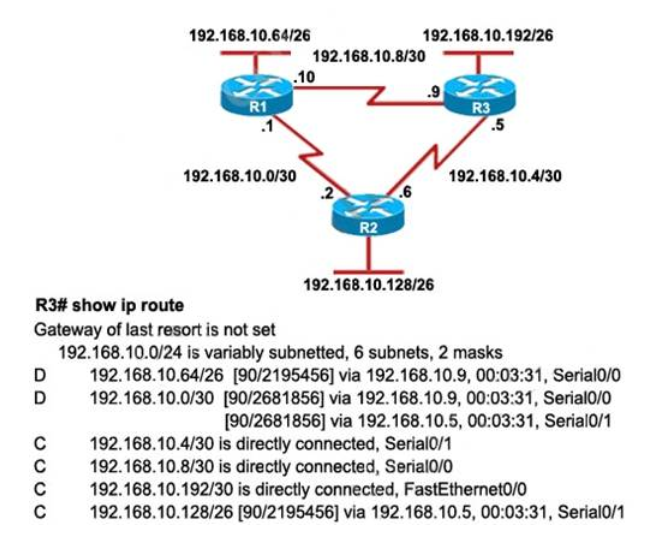 Correct
Correct
Incorrect
Hint
Host on the LAN attached to router R1 belongs to 192.168.10.64/26 subnet. From the output of the routing table of R3 we learn this network can be reach via 192.168.10.9, which is an IP address in 192.168.10.8/30 network (the network between R1 & R3) -> packets destined for 192.168.10.64 will be routed from R3 -> R1 -> LAN on R1. -
Question 49 of 133
49. Question
1 pointsRefer to the exhibit. The speed of all serial links is E1 and the speed of all Ethernet links is 100 Mb/s. A static route will be established on the Manchester router to direct traffic toward the Internet over the most direct path available. What configuration on the Manchester router will establish a route toward the Internet for traffic that originates from workstations on the Manchester LAN?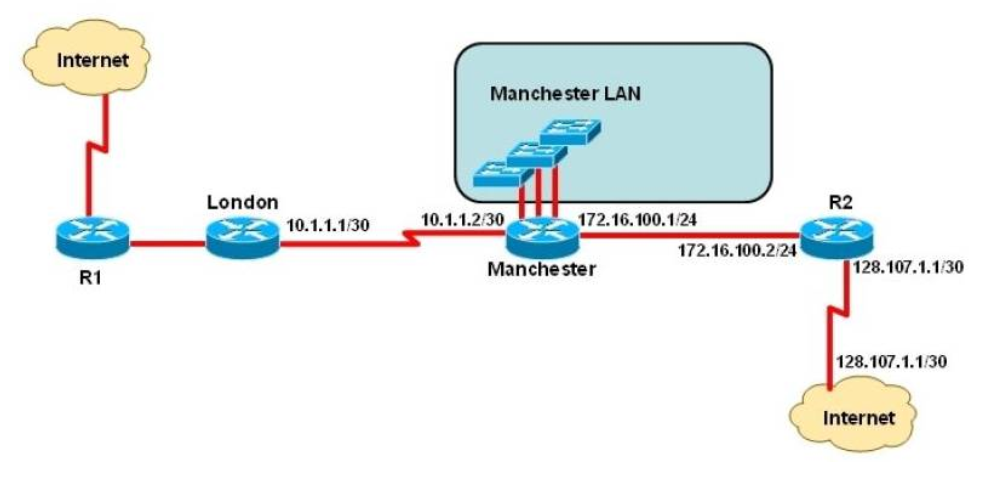 Correct
Correct
Incorrect
Hint
We use default routing to send packets with a remote destination network not in the routing table to the nexthop router. You should generally only use default routing on stub networks–those with only one exit path out of the network. According to exhibit, all traffic towards Internet that originates from workstations should forward to Router R1. Syntax for default route is: ip route . -
Question 50 of 133
50. Question
1 pointsRefer to the exhibit. The network administrator must establish a route by which London workstations can forward traffic to the Manchester workstations. What is the simplest way to accomplish this?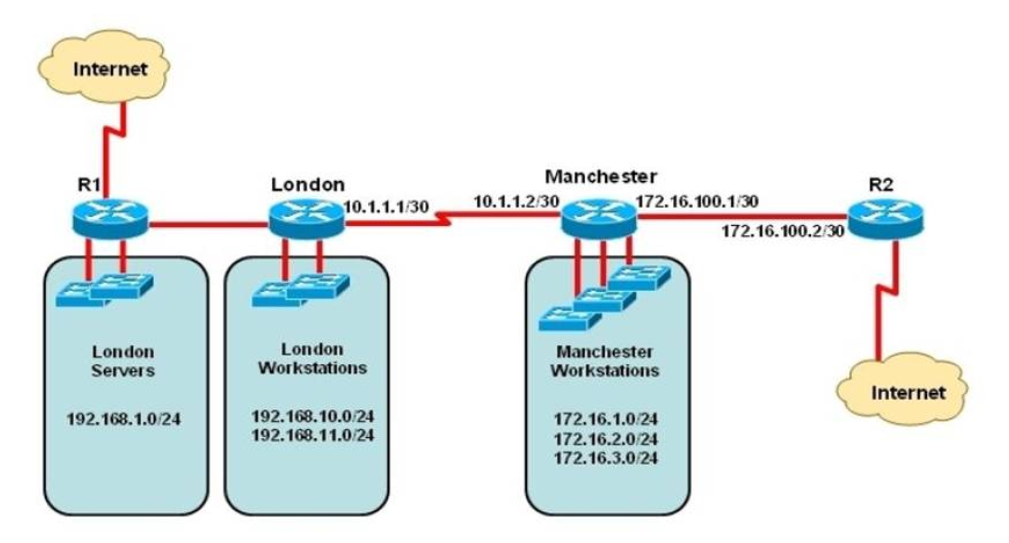 Correct
Correct
Incorrect
Hint
This static route will allow for communication to the Manchester workstations and it is better to use this more specific route than a default route as traffic destined to the Internet will then not go out the London Internet connection. -
Question 51 of 133
51. Question
1 pointsRefer to the exhibit. The network administrator requires easy configuration options and minimal routing protocol traffic. What two options provide adequate routing table information for traffic that passes between the two routers and satisfy the requests of the network administrator? (Choose two.)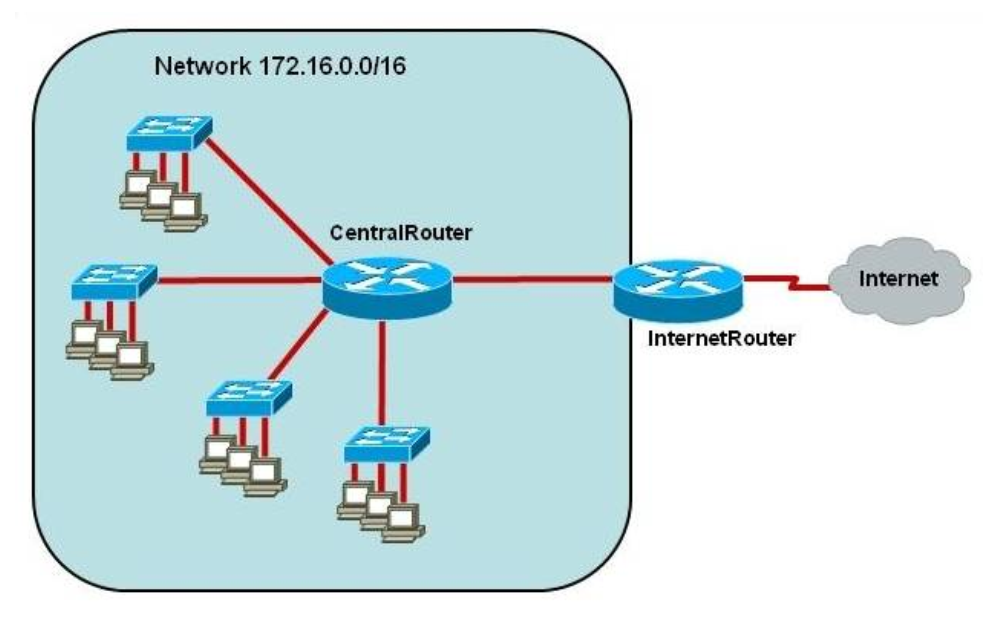 Correct
Correct
Incorrect
Hint
The use of static routes will provide the necessary information for connectivity while producing no routing traffic overhead. -
Question 52 of 133
52. Question
1 pointsWhich parameter or parameters are used to calculate OSPF cost in Cisco routers?Correct
Incorrect
Hint
http://www.cisco.com/c/en/us/support/docs/ip/open-shortest-path-first-ospf/7039-1.html#t6OSPF Cost The cost (also called metric) of an interface in OSPF is an indication of the overhead required to send packets across a certain interface. The cost of an interface is inversely proportional to the bandwidth of that interface. A higher bandwidth indicates a lower cost. There is more overhead (higher cost) and time delays involved in crossing a 56k serial line than crossing a 10M ethernet line. The formula used to calculate the cost is: cost= 10000 0000/bandwith in bps For example, it will cost 10 EXP8/10 EXP7 = 10 to cross a 10M Ethernet line and will cost 10 EXP8/1544000 = 64 to cross a T1 line. By default, the cost of an interface is calculated based on the bandwidth; you can force the cost of an interface with the ip ospf costinterface subconfiguration mode command. -
Question 53 of 133
53. Question
1 pointsWhich two statements about the OSPF Router ID are true? (Choose two.)Correct
Incorrect
-
Question 54 of 133
54. Question
1 pointsWhat are two benefits of using a single OSPF area network design? (Choose two.)Correct
Incorrect
-
Question 55 of 133
55. Question
1 pointsWhat OSPF command, when configured, will include all interfaces into area 0?Correct
Incorrect
-
Question 56 of 133
56. Question
1 pointsWhat two things will a router do when running a distance vector routing protocol? (Choose two.)Correct
Incorrect
Hint
Distance means how far and Vector means in which direction. Distance Vector routing protocols pass periodic copies of routing table to neighbor routers and accumulate distance vectors. In distance vector routing protocols, routers discover the best path to destination from each neighbor. The routing updates proceed step by step from router to router. -
Question 57 of 133
57. Question
1 pointsWhen a router undergoes the exchange protocol within OSPF, in what order does it pass through each state?Correct
Incorrect
-
Question 58 of 133
58. Question
1 pointsRefer to the exhibit. If the router Cisco returns the given output and has not had its router ID set manually, what value will OSPF use as its router ID? Correct
Correct
Incorrect
-
Question 59 of 133
59. Question
1 pointsWhat command sequence will configure a router to run OSPF and add network 10.1.1.0 /24 to area 0?Correct
Incorrect
-
Question 60 of 133
60. Question
1 pointsRefer to the exhibit. When running EIGRP, what is required for RouterA to exchange routing updates with RouterC?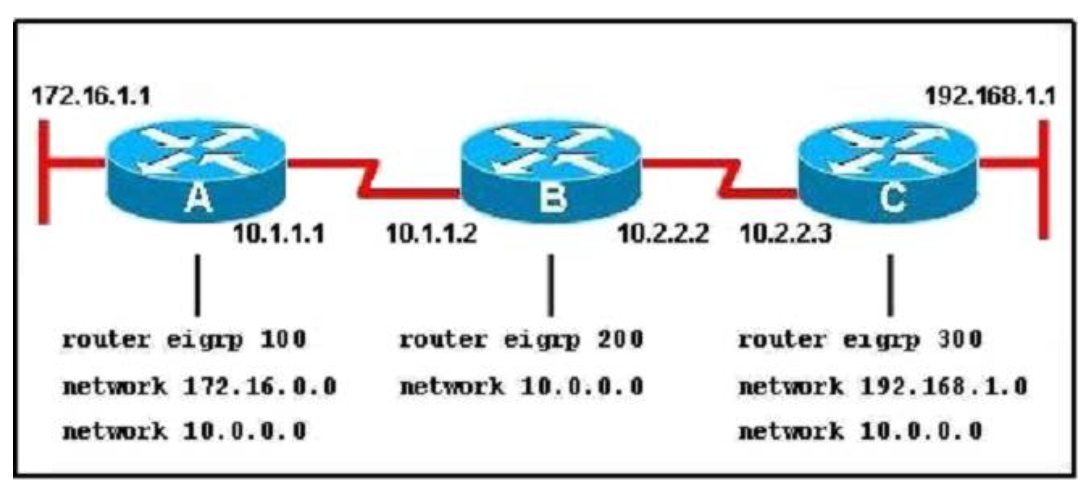 Correct
Correct
Incorrect
Hint
This question is to examine the understanding of the interaction between EIGRP routers. The following information must be matched so as to create neighborhood. EIGRP routers to establish, must match the following information: 1. AS Number; 2. K value. -
Question 61 of 133
61. Question
1 pointsA network administrator is trying to add a new router into an established OSPF network. The networks attached to the new router do not appear in the routing tables of the other OSPF routers. Given the information in the partial configuration shown below, what configuration error is causing this problem?Correct
Incorrect
Hint
When configuring OSPF, the mask used for the network statement is a wildcard mask similar to an access list. In this specific example, the correct syntax would have been “network 10.0.0.0 0.0.0.255 area 0. -
Question 62 of 133
62. Question
1 pointsRefer to the graphic. R1 is unable to establish an OSPF neighbor relationship with R3. What are possible reasons for this problem? (Choose two.)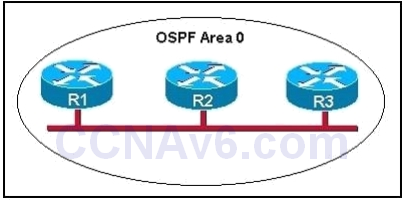 Correct
Correct
Incorrect
Hint
A is not correct because the backbone area of OSPF is always Area 0. B is not correct because R1 or R3 must be the DR or BDR -> it has to establish neighbor adjacency with the other. C is not correct because OSPF neighbor relationship is not established based on static routing. It uses multicast address 224.0.0.5 to establish OSPF neighbor relationship. E is not correct because configure EIGRP on these routers (with a lower administrative distance) will force these routers to run EIGRP, not OSPF.D and F are correct because these entries must match on neighboring routers:– Hello and dead intervals – Area ID (Area 0 in this case) – Authentication password – Stub area flag -
Question 63 of 133
63. Question
1 pointsWhich statement describes the process ID that is used to run OSPF on a router?Correct
Incorrect
-
Question 64 of 133
64. Question
1 pointsA router receives information about network 192.168.10.0/24 from multiple sources. What will the router consider the most reliable information about the path to that network?Correct
Incorrect
Hint
When there is more than one way to reach a destination, it will choose the best one based on a couple of things. First, it will choose the route that has the longest match; meaning the most specific route. So, in this case the /24 routes will be chosen over the /16 routes. Next, from all the /24 routes it will choose the one with the lowest administrative distance. Directly connected routes have an AD of 1 so this will be the route chosen. -
Question 65 of 133
65. Question
1 pointsWhat is the default maximum number of equal-cost paths that can be placed into the routing table of a Cisco OSPF router?Correct
Incorrect
Hint
maximum-paths (OSPF) To control the maximum number of parallel routes that Open Shortest Path First (OSPF) can support, use the maximum-paths command. Syntax Description maximum Maximum number of parallel routes that OSPF can install in a routing table. The range is from 1 to 16 routes. Command Default 8 paths -
Question 66 of 133
66. Question
1 pointsRefer to the exhibit. After a RIP route is marked invalid on Router_1, how much time will elapse before that route is removed from the routing table?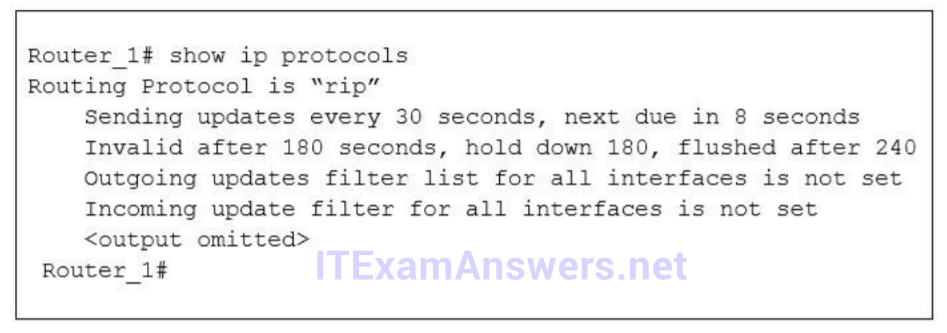 Correct
Correct
Incorrect
Hint
What you need to read up on is around the Count to infinity routing loops, the holddown timers are used to ensure that routing loops dont occur and the hold down timer only occurs after 180s then at 240s the bad route is flushed/deleted. Coming back to the question where it asks for the time elapsed before it gets removed. So once the holddown timer passes thats when it knows there is a bad route, then the question is asking how long does it stay in the routing table before it gets “flushed” so that is 240-180=60s -
Question 67 of 133
67. Question
1 pointsRefer to the exhibit. A network associate has configured the internetwork that is shown in the exhibit, but has failed to configure routing properly. Which configuration will allow the hosts on the Branch LAN to access resources on the HQ LAN with the least impact on router processing and WAN bandwidth? Correct
Which configuration will allow the hosts on the Branch LAN to access resources on the HQ LAN with the least impact on router processing and WAN bandwidth? Correct
Incorrect
-
Question 68 of 133
68. Question
1 pointsRefer to the exhibit. The network is converged. After link-state advertisements are received from Router_A, what information will Router_E contain in its routing table for the subnets 208.149.23.64 and 208.149.23.96?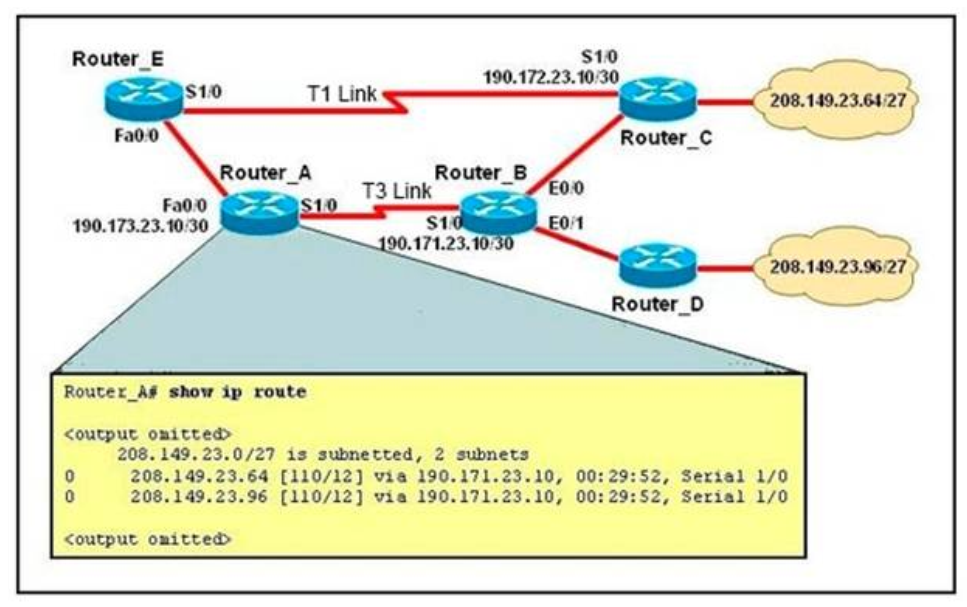 Correct
Correct
Incorrect
-
Question 69 of 133
69. Question
1 pointsWhich statement is true, as relates to classful or classless routing?Correct
Incorrect
-
Question 70 of 133
70. Question
1 pointsWhich pairing reflects a correct protocol-and-metric relationship?Correct
Incorrect
-
Question 71 of 133
71. Question
1 pointsRefer to the exhibit. Which two statements are true about the loopback address that is configured on RouterB? (Choose two.)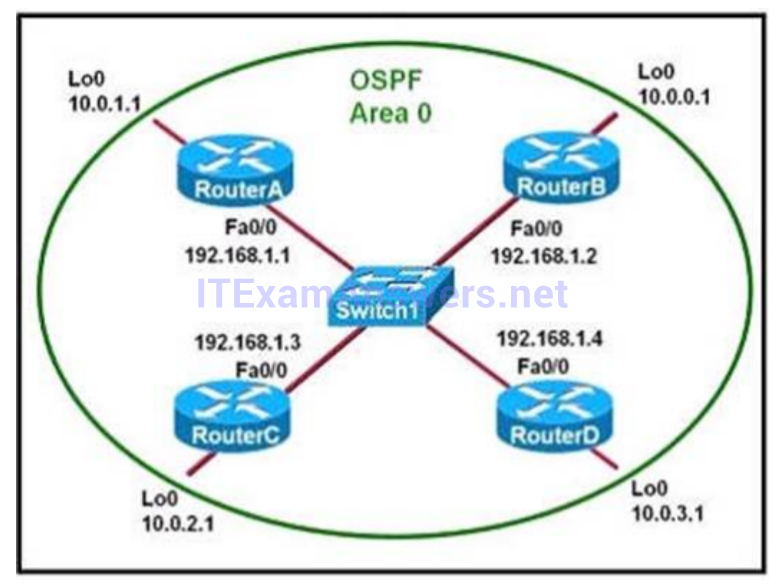 Correct
Correct
Incorrect
-
Question 72 of 133
72. Question
1 pointsRefer to the exhibit. The router has been configured with these commands: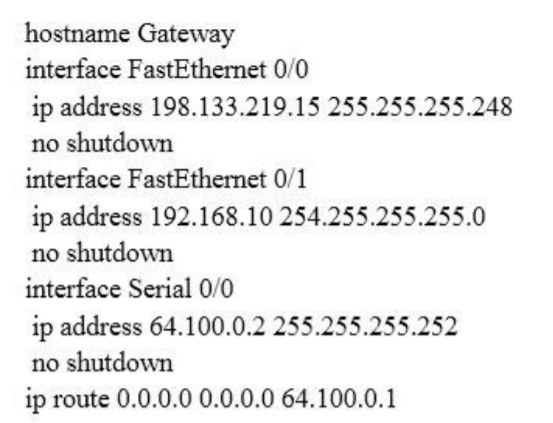 What are the two results of this configuration? (Choose two.)
What are the two results of this configuration? (Choose two.)
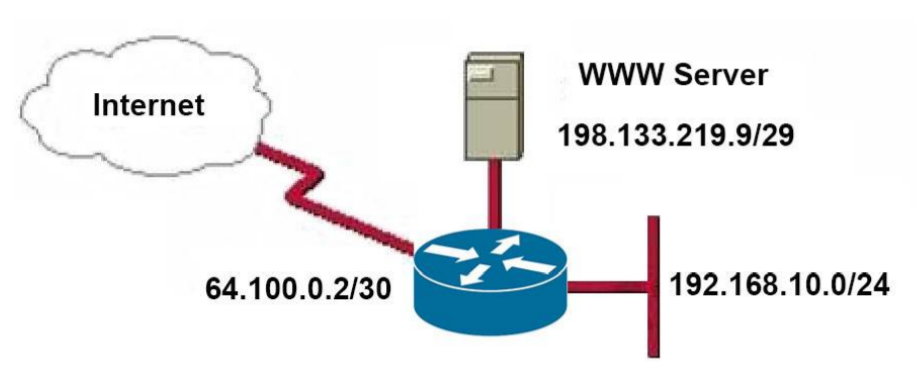
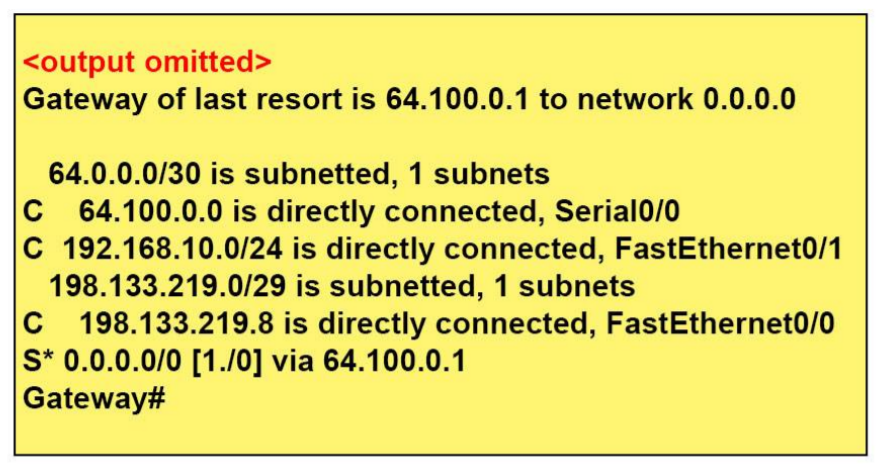 Correct
Correct
Incorrect
-
Question 73 of 133
73. Question
1 pointsWhich two statements are true about the command ip route 172.16.3.0 255.255.255.0 192.168.2.4? (Choose two.)Correct
Incorrect
-
Question 74 of 133
74. Question
1 pointsRefer to the exhibit. The networks connected to router R2 have been summarized as a 192.168.176.0/21 route and sent to R1. Which two packet destination addresses will R1 forward to R2? (Choose two.)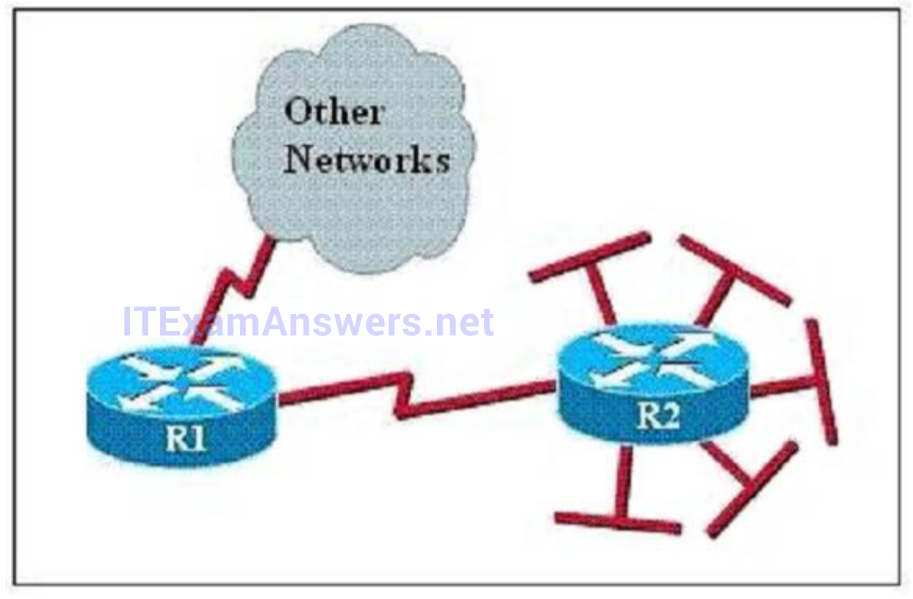 Correct
Correct
Incorrect
-
Question 75 of 133
75. Question
1 pointsRefer to the exhibit. Which three statements are true about how router JAX will choose a path to the 10.1.3.0/24 network when different routing protocols are configured? (Choose three.)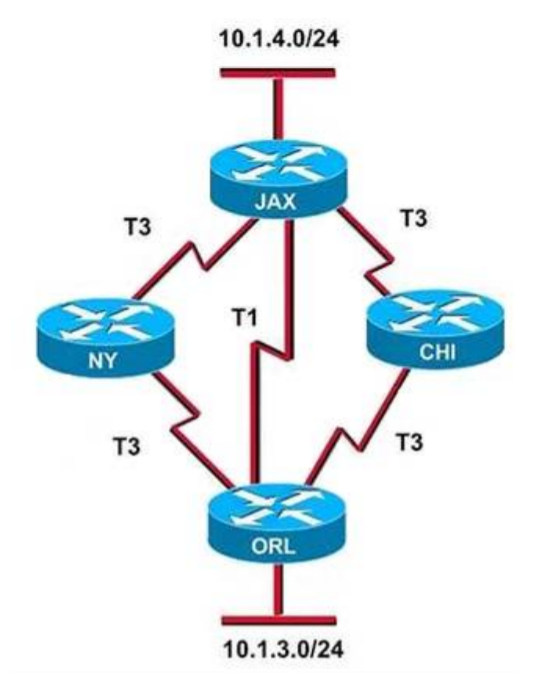 Correct
Correct
Incorrect
-
Question 76 of 133
76. Question
1 pointsIn which situation would the use of a static route be appropriate?Correct
Incorrect
-
Question 77 of 133
77. Question
1 pointsWhich three statements are correct about RIP version 2? (Choose three)Correct
Incorrect
-
Question 78 of 133
78. Question
1 pointsWhich address is the IPv6 all-RIP-routers multicast group address that is used by RIPng as the destination address for RIP updates?Correct
Incorrect
-
Question 79 of 133
79. Question
1 pointsIf all OSPF routers in a single area are configured with the same priority value, what value does a router use for the OSPF router ID in the absence of a loopback interface?<Correct
Incorrect
-
Question 80 of 133
80. Question
1 pointsThe OSPF Hello protocol performs which of the following tasks? (Choose two.)Correct
Incorrect
-
Question 81 of 133
81. Question
1 pointsThe network administrator of the Oregon router adds the following command to the router configuration: ip route 192.168.12.0 255.255.255.0 172.16.12.1. What are the results of adding this command? (Choose two.)Correct
Incorrect
-
Question 82 of 133
82. Question
1 pointsThe Company WAN is migrating from RIPv1 to RIPv2. Which three statements are correct about RIP version 2? (Choose three.)Correct
Incorrect
-
Question 83 of 133
83. Question
1 pointsWhich EIGRP for IPv6 command can you enter to view the link-local addresses of the neighbors of a device?Correct
Incorrect
Hint
The “show ipv6 eigrp neighbors” command displays the neighbors discovered by the EIGRPv6. Notice that the neighbors are displayed by their link-local addresses.
-
Question 84 of 133
84. Question
1 pointsRefer to the exhibit. Router edge-1 is unable to establish OSPF neighbor adjacency with router ISP-1. Which two configuration changes can you make on edge-1 to allow the two routers to establish adjacency? (Choose two) Correct
Correct
Incorrect
Hint
In order to become OSPF neighbor following values must be match on both routers:+ Area ID + Authentication + Hello and Dead Intervals + Stub Flag + MTU SizeTherefore we need to adjust the MTU size on one of the router so that they are the same. Or we can tell OSPF to ignore the MTU size check with the command “ip ospf mtu-ignore”. -
Question 85 of 133
85. Question
1 pointsYou enter the show ipv6 route command on an OSPF device and the device displays a route. Which conclusion can you draw about the environment?Correct
Incorrect
Hint
The “show ipv6 route” displays the current contents of the IPv6 routing table. This device is running OSPF so we can deduce it is running OSPFv3 (OSPF for IPv6). An example of the “show ip v6 route” is shown below: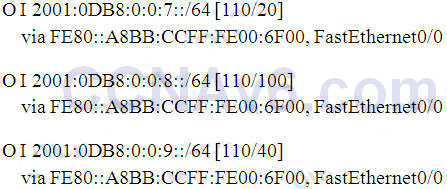
-
Question 86 of 133
86. Question
1 pointsWhich routing protocol has the smallest default administrative distance?Correct
Incorrect
Hint
The Administrative Distance (AD) of popular routing protocols is shown below. You should learn them by heart: Note: The AD of iBGP is 200
The smaller the AD is, the better it is. The router will choose the routing protocol with smallest AD.
In this case EIGRP with AD of 90 is the smallest one.
Note: The AD of iBGP is 200
The smaller the AD is, the better it is. The router will choose the routing protocol with smallest AD.
In this case EIGRP with AD of 90 is the smallest one. -
Question 87 of 133
87. Question
1 pointsWhich statement about static routes is true?Correct
Incorrect
Hint
Static routing can be used to define an exit point from a router when no other routes are available or necessary. This is called a default route. -
Question 88 of 133
88. Question
1 pointsWhich statement about routing protocols is true?Correct
Incorrect
Hint
Link State Routing Protocols Link state protocols are also called shortest-path-first protocols. Link state routing protocols have a complete picture of the network topology. Hence they know more about the whole network than any distance vector protocol. Three separate tables are created on each link state routing enabled router. One table is used to hold details about directly connected neighbors, one is used to hold the topology of the entire internetwork and the last one is used to hold the actual routing table. Link state protocols send information about directly connected links to all the routers in the network. Examples of Link state routing protocols include OSPF – Open Shortest Path First and IS-IS – Intermediate System to Intermediate System. There are also routing protocols that are considered to be hybrid in the sense that they use aspects of both distance vector and link state protocols. EIGRP – Enhanced Interior Gateway Routing Protocol is one of those hybrid routing protocols. -
Question 89 of 133
89. Question
1 pointsWhich dynamic routing protocol uses only the hop count to determine the best path to a destination?Correct
Incorrect
-
Question 90 of 133
90. Question
1 pointsWhen a device learns multiple routes to a specific network, it installs the route with :Correct
Incorrect
Hint
Making a forwarding decision actually consists of three sets of processes: the routing protocols, the routing table, and the actual process which makes a forwarding decision and switches packets. The longest prefix match always wins among the routes actually installed in the routing table, while the routing protocol with the lowest administrative distance always wins when installing routes into the routing table.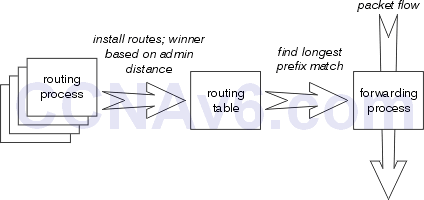 Reference: http://www.cisco.com/c/en/us/support/docs/ip/enhanced-interior-gateway-routing-protocol-eigrp/8651-21.html
Reference: http://www.cisco.com/c/en/us/support/docs/ip/enhanced-interior-gateway-routing-protocol-eigrp/8651-21.html -
Question 91 of 133
91. Question
1 pointsOSPF enable on interface with multiple ipv6 prefix which ip will OSPF use?Correct
Incorrect
-
Question 92 of 133
92. Question
1 pointsWhich type of routing protocol operates by using first information from each device peers?Correct
Incorrect
Hint
http://www.ciscopress.com/articles/article.asp?p=24090&seqNum=4 The reason is that unlike the routing-by-rumor approach of distance vector, link state routers have firsthand information from all their peer routers. Each router originates information about itself, its directly connected links, and the state of those links (hence the name). This information is passed around from router to router, each router making a copy of it, but never changing it. The ultimate objective is that every router has identical information about the internetwork, and each router will independently calculate its own best paths. -
Question 93 of 133
93. Question
1 pointsWhich statements is true about Router on Stick?Correct
Incorrect
-
Question 94 of 133
94. Question
1 pointsWhat are two enhancements that OSPFv3 supports over OSPFv2? (Choose two.)Correct
Incorrect
-
Question 95 of 133
95. Question
1 pointsWhat are two drawbacks of implementing a link-state routing protocol? (Choose two)Correct
Incorrect
-
Question 96 of 133
96. Question
1 pointsWhich command is needed to send RIPv2 updates as broadcast when configured for RIPv2?Correct
Incorrect
Hint
Reference: https://www.cisco.com/c/en/us/td/docs/ios/12_2/iproute/command/reference/fiprrp_r/1rfrip.html -
Question 97 of 133
97. Question
1 pointsRouter R1 has a static route that is configured to destination network.A directly connected interface is configured with an IP address in the same destination network.Which statement about R1 is true?Correct
Incorrect
-
Question 98 of 133
98. Question
1 pointsWhich feature is configured by setting a variance that is at least two times the metric?Correct
Incorrect
Hint
EIGRP provides a mechanism to load balance over unequal cost paths (or called unequal cost load balancing) through the “variance” command. In other words, EIGRP will install all paths with metric < variance * best_metric into the local routing table, provided that it meets the feasibility condition (to prevent routing loop). The feasibility condition states that, the Advertised Distance (AD) of a route must be lower than the feasible distance of the current successor route. -
Question 99 of 133
99. Question
1 pointsWhich command can you enter to display the operational status of the network ports on a router?Correct
Incorrect
-
Question 100 of 133
100. Question
1 pointsinterface fa0/0 ip address x.x.x.33 255.255.255.224 router bgp XXX neighbor x.x.x.x remote as x.x.x.x You need to advertise the network of Int fa0/0.Correct
Incorrect
-
Question 101 of 133
101. Question
1 pointsWhen enabled, which feature prevents routing protocols from sending hello messages on an interface?Correct
Incorrect
Hint
You can use the passive-interface command in order to control the advertisement of routing information. The command enables the suppression of routing updates over some interfaces while it allows updates to be exchanged normally over other interfaces. With most routing protocols, the passive-interface command restricts outgoing advertisements only. But, when used with Enhanced Interior Gateway Routing Protocol (EIGRP), the effect is slightly different. This document demonstrates that use of the passive-interface command in EIGRP suppresses the exchange of hello packets between two routers, which results in the loss of their neighbor relationship. This stops not only routing updates from being advertised, but it also suppresses incoming routing updates. This document also discusses the configuration required in order to allow the suppression of outgoing routing updates, while it also allows incoming routing updates to be learned normally from the neighbor -
Question 102 of 133
102. Question
1 pointsWhich value is indicated by the next hop in a routing table?Correct
Incorrect
-
Question 103 of 133
103. Question
1 pointsWhich two are advantages of static routing when compared to dynamic routing? (Choose two.)Correct
Incorrect
Hint
Since static routing is a manual process, it can be argued that it is more secure (and more prone to human errors) since the network administrator will need to make changes to the routing table directly. Also, in stub networks where there is only a single uplink connection, the load is reduced as stub routers just need a single static default route, instead of many routes that all have the same next hop IP address. -
Question 104 of 133
104. Question
1 pointsRefer to exhibit. What Administrative distance has route to 192.168.10.1 ? Correct
Correct
Incorrect
-
Question 105 of 133
105. Question
1 pointsRefer to the exhibit.After you apply the given configuration to R1, you determine that it is failing to advertise the 172.16.10.32/27 network .Which action most likely to correct the problem. Correct
Correct
Incorrect
Hint
The difference between RIPv1 and RIPv2 is RIPv1 is a classful protocol (no support for VLSM or CIDR) while RIPv2 is a classless protocol (which supports VLSM and CIDR). Therefore in this question if we forget to enable RIPv2 then the router will use RIPv1 and it only advertise major network 172.16.0.0/16 to other routers. By enabling RIPv2 (via the “version 2” command) the router will advertise two subnets 172.16.10.0/27 & 172.16.10.32/28. -
Question 106 of 133
106. Question
1 pointsUnder which circumstance is a router on a stick most appropriate?Correct
Incorrect
-
Question 107 of 133
107. Question
1 pointsWhich type of routing protocol operates by exchanging the entire routing information ?Correct
Incorrect
Hint
Distance vector protocols (like RIP) exchanges the entire routing information each time the routers send the updates.Note: EIGRP is considered an advanced distance vector protocol so it does not send the whole routing table for each update. -
Question 108 of 133
108. Question
1 pointsWhen is a routing table entry identified as directly connected?Correct
Incorrect
-
Question 109 of 133
109. Question
1 pointsRefer to the exhibit. What is the effect of the given configuration?Switch#configuration terminal Switch#interface VLAN 1 Switch(config-if)#ip address 192.168.2.2 255.255.255.0 Switch(config-if)#end
Correct
Incorrect
Hint
In the configuration above, the “no shutdown” command was missing so interface Vlan 1 is still inactive. Notice that only the loopback command does not need the “no shutdown” command to work. -
Question 110 of 133
110. Question
1 pointsWhich function enables an administrator to route multiple VLANs on a router?Correct
Incorrect
-
Question 111 of 133
111. Question
1 pointsWhich path does a router choose when it receives a packet with multiple possible paths to the destination over different routing protocols?Correct
Incorrect
-
Question 112 of 133
112. Question
1 pointsWhich three characteristics are representative of a link-state routing protocol? (Choose three.)Correct
Incorrect
-
Question 113 of 133
113. Question
1 pointsWhich command can you enter to set the default route for all traffic to an IP enabled router interface?Correct
Incorrect
-
Question 114 of 133
114. Question
1 pointsWhat are two advantages of static routing? (Choose two.)Correct
Incorrect
-
Question 115 of 133
115. Question
1 pointsWhich two advantages do dynamic routing protocols provide over static routing? (Choose two.)Correct
Incorrect
-
Question 116 of 133
116. Question
1 pointsYou have configured a router with an OSPF router ID, but its IP address still reflects the physical interface. Which action can you take to correct the problem in the least disruptive way?Correct
Incorrect
-
Question 117 of 133
117. Question
1 pointsWhich two neighbor types are supported in a BGP environment? (Choose two.)Correct
Incorrect
-
Question 118 of 133
118. Question
1 pointsWhich two differences between distance-vector and link-state routing protocols are true? (Choose two.)Correct
Incorrect
-
Question 119 of 133
119. Question
1 pointsFor which routes does the distance bgp 10 50 70 command set the administrative distance?Correct
Incorrect
-
Question 120 of 133
120. Question
1 pointsWhich 2 optns are requirements for configuring ripv2 for ipv4 (choose 2 )?Correct
Incorrect
Hint
To enable RIP surely we have to enable it first (with the “router rip” command in global configuration mode) -> E is correct. RIPv2 sends its updates via multicast but in Nonbroadcast Multiple Access (NBMA) environment, multicast is not allowed so we have to use unicast to send RIPv2 updates -> D is correct. -
Question 121 of 133
121. Question
1 pointsWhich two steps must you perform to enbale router- on- stick on a switch?Correct
Incorrect
Hint
This question only asks about enable router-on-stick on a switch, not a router. We don’t have subinterface on a switch so B is not a correct answer. -
Question 122 of 133
122. Question
1 pointsWhich add prefix does OSPFv3 use when multiple IPv6 address are configured on a single interface?Correct
Incorrect
Hint
http://www.cisco.com/c/en/us/td/docs/ios-xml/ios/iproute_ospf/configuration/15-sy/iro-15-sy-book/ip6-routeospfv3.html#GUID-05F3F09C-FE3E-41D6-9845-111FB17AD030 “In IPv6, you can configure many address prefixes on an interface. In OSPFv3, all address prefixes on an interface are included by default. You cannot select some address prefixes to be imported into OSPFv3; either all address prefixes on an interface are imported, or no address prefixes on an interface are imported.” -
Question 123 of 133
123. Question
1 pointsWhich command can you enter to configure an IPV6 floating static route?Correct
Incorrect
Hint
Floating static routes are static routes that have an administrative distance greater than the administrative distance (AD) of another static route or dynamic routes. By default a static route has an AD of 1 then floating static route must have the AD greater than 1 -> Answer C is correct as it has the AD of 201. -
Question 124 of 133
124. Question
1 pointsRefer to the exhibit.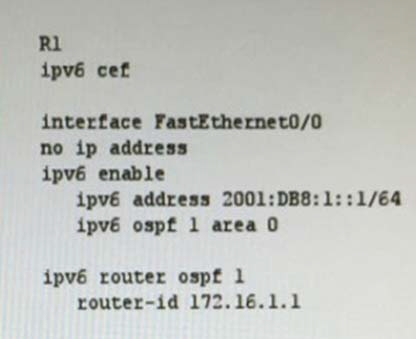 After you apply the given configuration to R1, you notice that it failed to enable OSPF Which action can you take to correct the problem? Correct
After you apply the given configuration to R1, you notice that it failed to enable OSPF Which action can you take to correct the problem? Correct
Incorrect
Hint
http://www.cisco.com/c/en/us/td/docs/ios-xml/ios/iproute_ospf/configuration/15-sy/iro-15-sy-book/ip6-route-ospfv3.html Prerequisites for IPv6 Routing: OSPFv3 Complete the OSPFv3 network strategy and planning for your IPv6 network. For example, you must decide whether multiple areas are required. Enable IPv6 unicast routing. Enable IPv6 on the interface. -
Question 125 of 133
125. Question
1 pointsWhich effect of the passive-interface command on R1 is true? Correct
Correct
Incorrect
Hint
With most routing protocols, the passive-interface command restricts outgoing advertisements only. But, when used with Enhanced Interior Gateway Routing Protocol (EIGRP), the effect is slightly different. -
Question 126 of 133
126. Question
1 pointsWhich component of a routing table entry represents the subnet mask?Correct
Incorrect
Hint
IP Routing Table Entry Types An entry in the IP routing table contains the following information in the order presented: Network ID. The network ID or destination corresponding to the route. The network ID can be class- based, subnet, or supernet network ID, or an IP address for a host route. Network Mask. The mask that is used to match a destination IP address to the network ID. Next Hop. The IP address of the next hop. Interface. An indication of which network interface is used to forward the IP packet. Metric. A number used to indicate the cost of the route so the best route among possible multiple routes to the same destination can be selected. A common use of the metric is to indicate the number of hops (routers crossed) to the network ID. Routing table entries can be used to store the following types of routes: Directly Attached Network IDs. Routes for network IDs that are directly attached. For directly attached networks, the Next Hop field can be blank or contain the IP address of the interface on that network. Remote Network IDs. Routes for network IDs that are not directly attached but are available across other routers. For remote networks, the Next Hop field is the IP address of a local router in between the forwarding node and the remote network. Host Routes. A route to a specific IP address. Host routes allow routing to occur on a per-IP address ba- sis. For host routes, the network ID is the IP address of the specified host and the network mask is 255.255.255.255. Default Route. The default route is designed to be used when a more specific network ID or host route is not found. The default route network ID is 0.0.0.0 with the network mask of 0.0.0.0. -
Question 127 of 133
127. Question
1 pointsDRAG DROP. Drag and drop the BGP components from the left onto the correct descriptions on the right. Select and Place: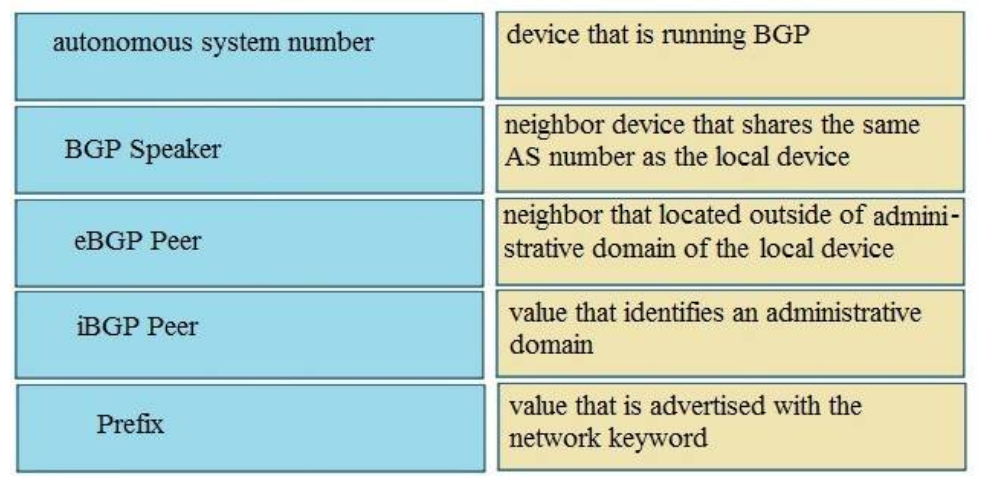
Sort elements
- BGP Speaker
- iBGP Peer
- eBGP Peer
- autonomous system number
- Prefix
-
device that is running BGP
-
neighbor device that shares the same AS number as the local device
-
neighbor that located outside of admini-strative domain of the local device
-
value that identifies an administrative domain
-
value that is advertised with the network keyword
Correct
Incorrect
-
Question 128 of 133
128. Question
1 pointsDRAG DROP. Drag each definition on the left to the matching term on the right. Select and Place: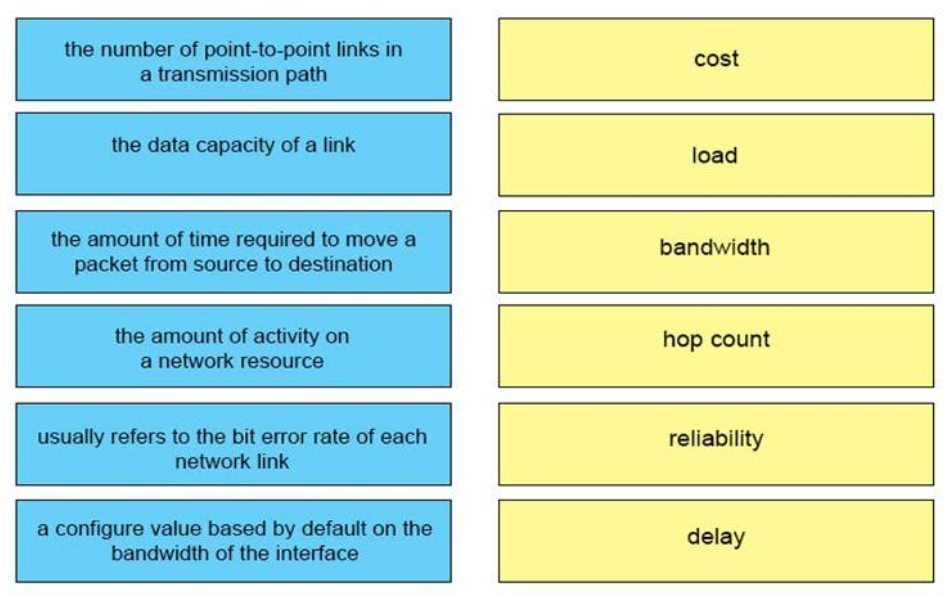
Sort elements
- a configure value based by default on the bandwidth of the interface
- the amount of activity on a network resource
- the data capacity of a link
- the number of point-to-point links in a transmission path
- usually refers to the bit error rate of each network link
- the amount of time required to move a packet from source to destination
-
cost
-
load
-
bandwidth
-
hop count
-
reliability
-
delay
Correct
Incorrect
-
Question 129 of 133
129. Question
1 pointsDRAG DROP. Drag the Cisco default administrative distance to the appropriate routing protocol or route. (Not all options are used.) Select and Place: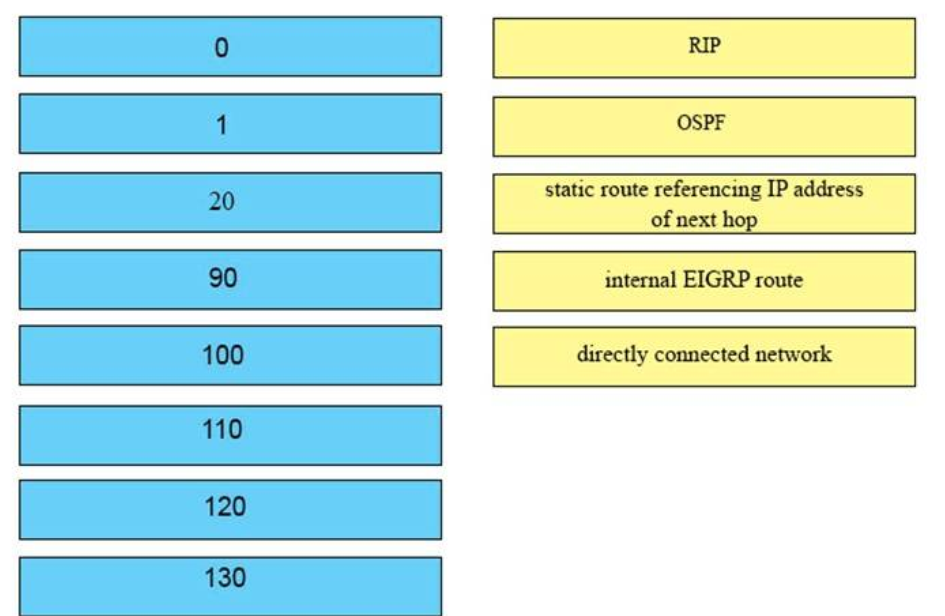
Sort elements
- 120
- 110
- 1
- 90
- 0
- 20
- 100
- 130
-
RIP
-
OSPF
-
static route referencing IP address of next hop
-
internal EIRGP route
-
directly conected network
Correct
Incorrect
-
Question 130 of 133
130. Question
1 pointsDRAG DROP. Routing has been configured on the local router with these commands: Drag each destination IP address on the left to its correct next hop address on the right.
Select and Place:
Drag each destination IP address on the left to its correct next hop address on the right.
Select and Place:
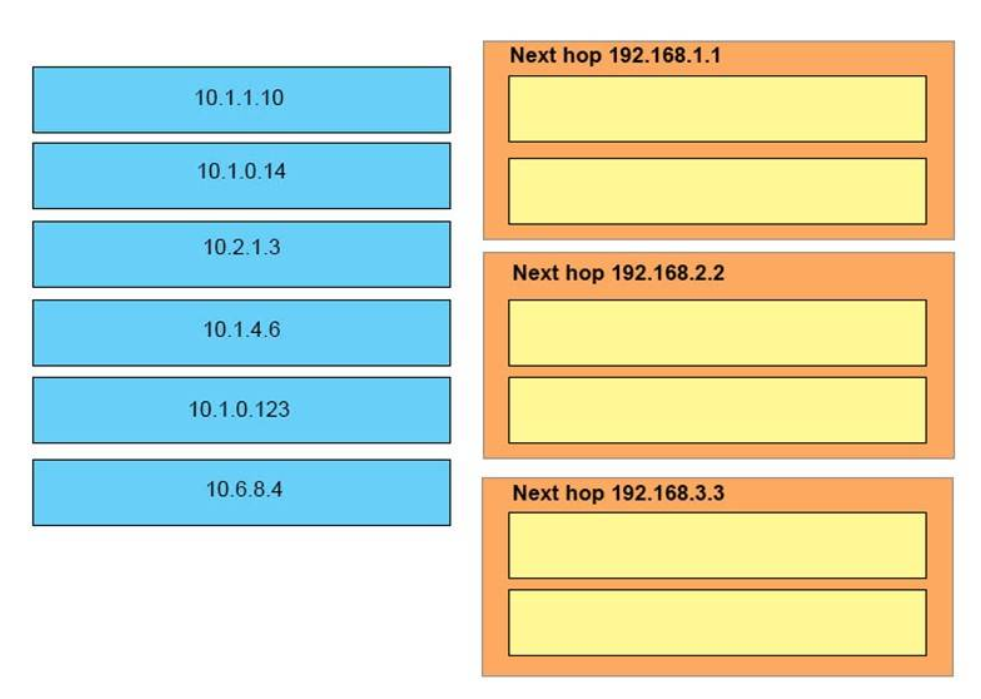
Sort elements
- 10.2.1.3
- 10.6.8.4
- 10.1.0.14
- 10.1.0.123
- 10.1.1.10
- 10.1.4.6
-
Next hop 192.168.1.1 (A)
-
Next hop 192.168.1.1 (B)
-
Next hop 192.168.2.2 (A)
-
Next hop 192.168.2.2 (B)
-
Next hop 192.168.3.3 (A)
-
Next hop 192.168.3.3 (B)
Correct
Incorrect
-
Question 131 of 133
131. Question
1 pointsDRAG DROP. Drag and drop each advantage of static or dynamic routing from the left onto the correct routing type on the right. Select and Place: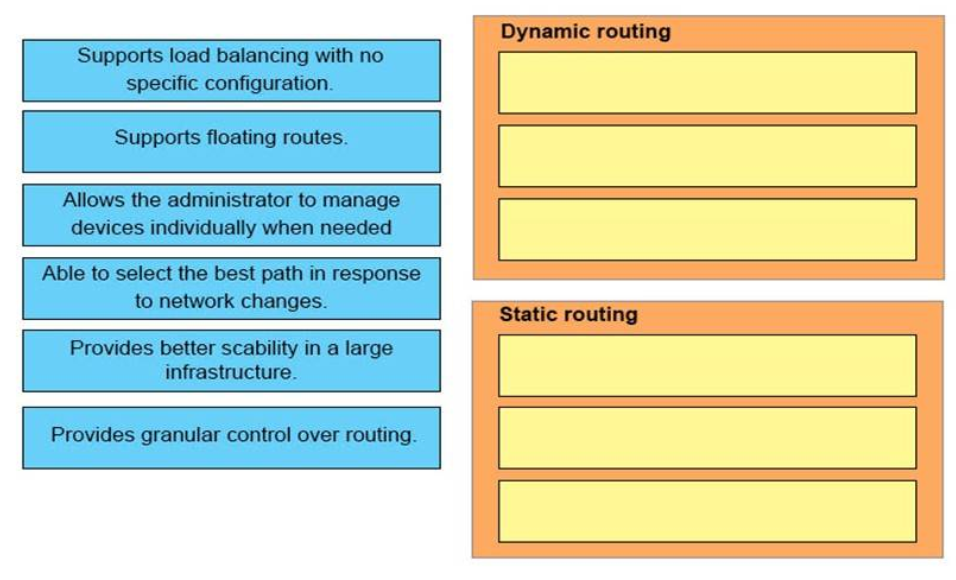
Sort elements
- Supports load balancing with no specific configuration
- Able to select the best path in responsive to network changes
- Provides better scability in a large infrastructure
- Supports floating routes
- Allows the adminitrator to manage devices individually when needed
- Provides granular control over routing
-
Dynamic routing (1)
-
Dynamic routing (2)
-
Dynamic routing (2)
-
Static routing (1)
-
Static routing (2)
-
Static routing (3)
Correct
Incorrect
-
Question 132 of 133
132. Question
1 pointsDRAG DROP. Drag and drop the BGP terms from the left onto the correct descriptions on the right.Select and Place:
Sort elements
- prefix
- external BGP
- internal BGP
- autonomous system
- public AS range
- private AS range
-
block of IP addresses
-
relationship between peers in different autonomous system
-
relationship between peers in the same autonomous system
-
separate network operating within one administratives domain
-
value between 1 and 64,511
-
value between 64,512 and 65,535
Correct
Incorrect
-
Question 133 of 133
133. Question
1 pointsDRAG DROP. Drag and drop the values in a routing table from the left onto the correct meanings on the right.Select and Place: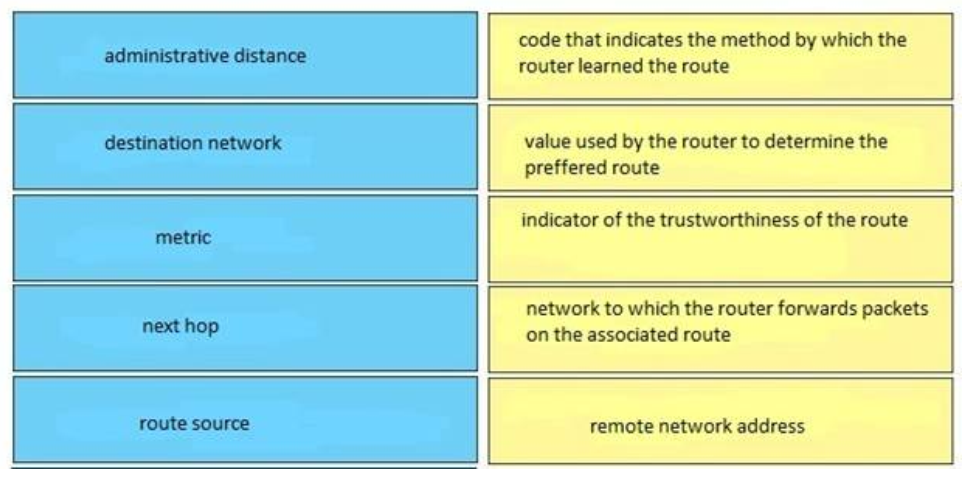
Sort elements
- route source
- metric
- administrative distance
- next hop
- destination network
-
code that indicates the method by which the router learned the route
-
value used by the router to determine preffered route
-
indicator of the trustworthiness of the route
-
network to which the router forwards packets on the associated route
-
remote network address
Correct
Incorrect
